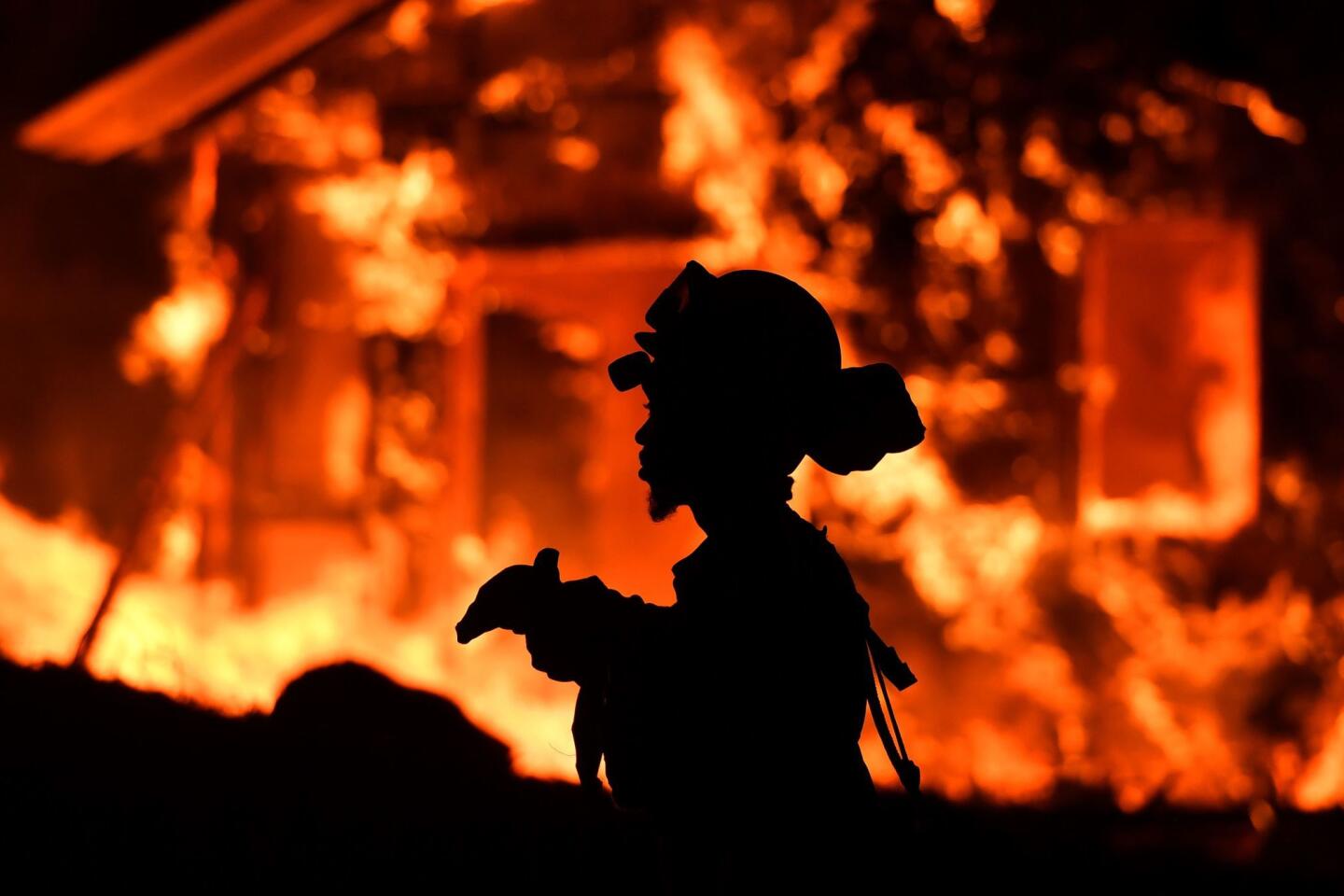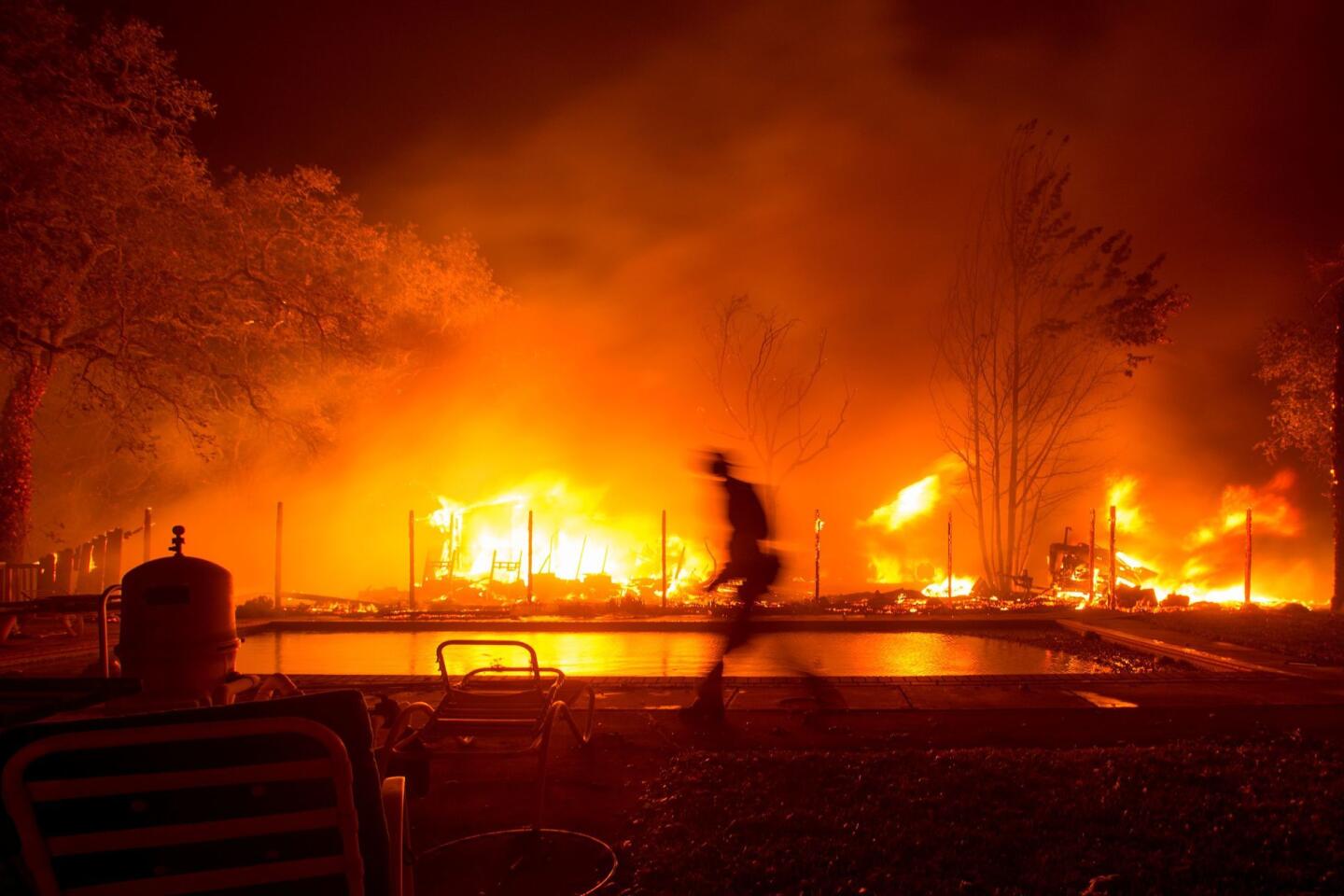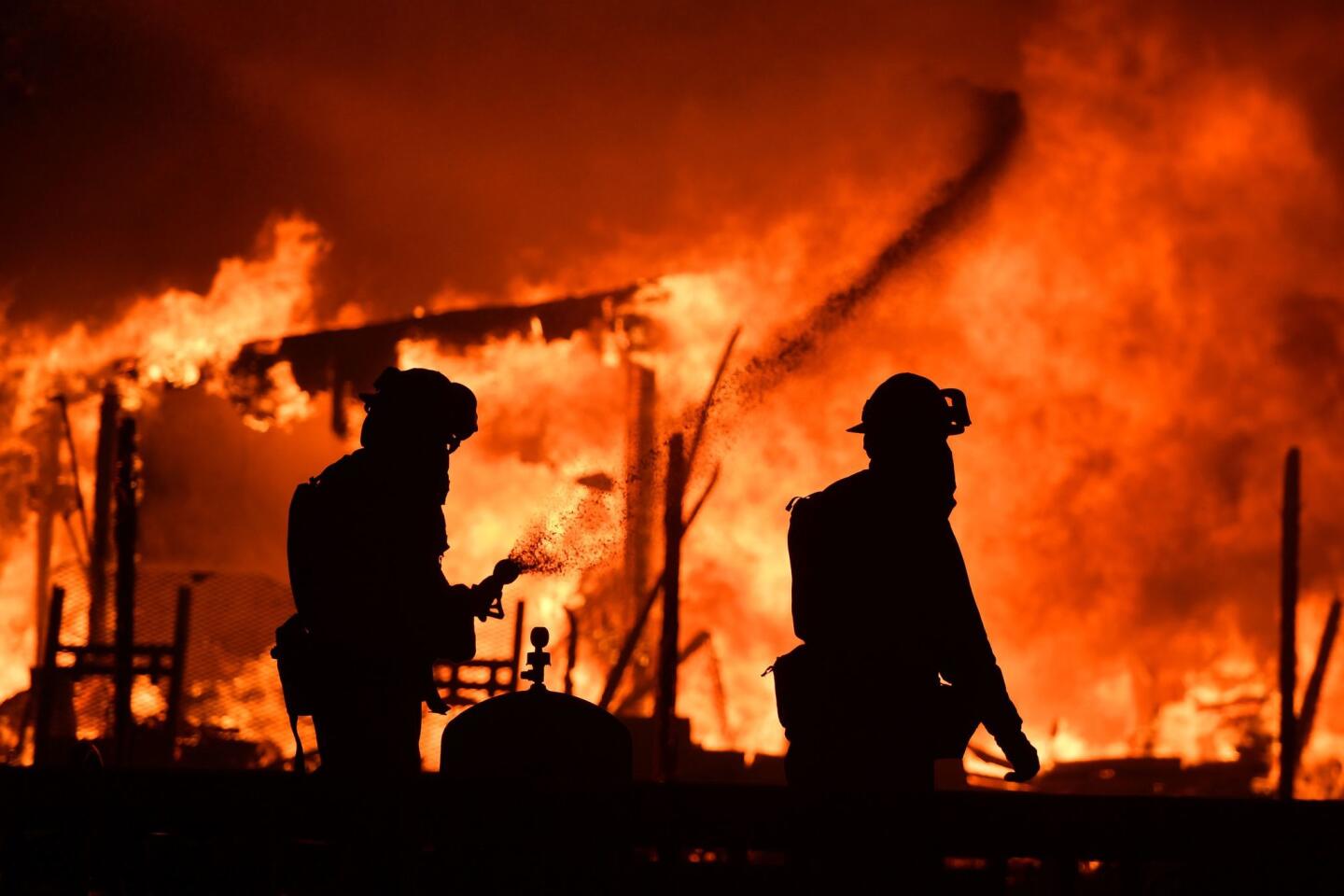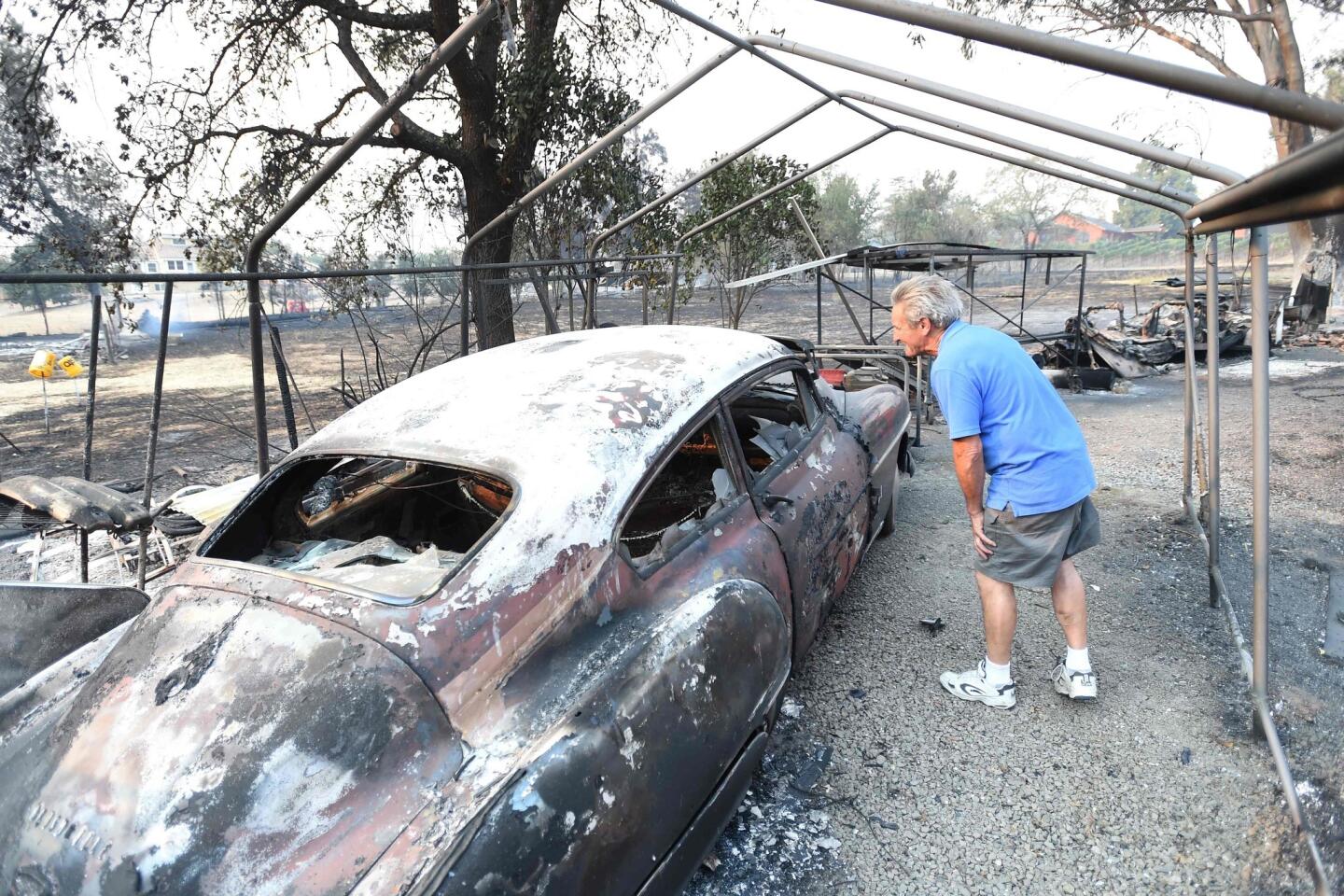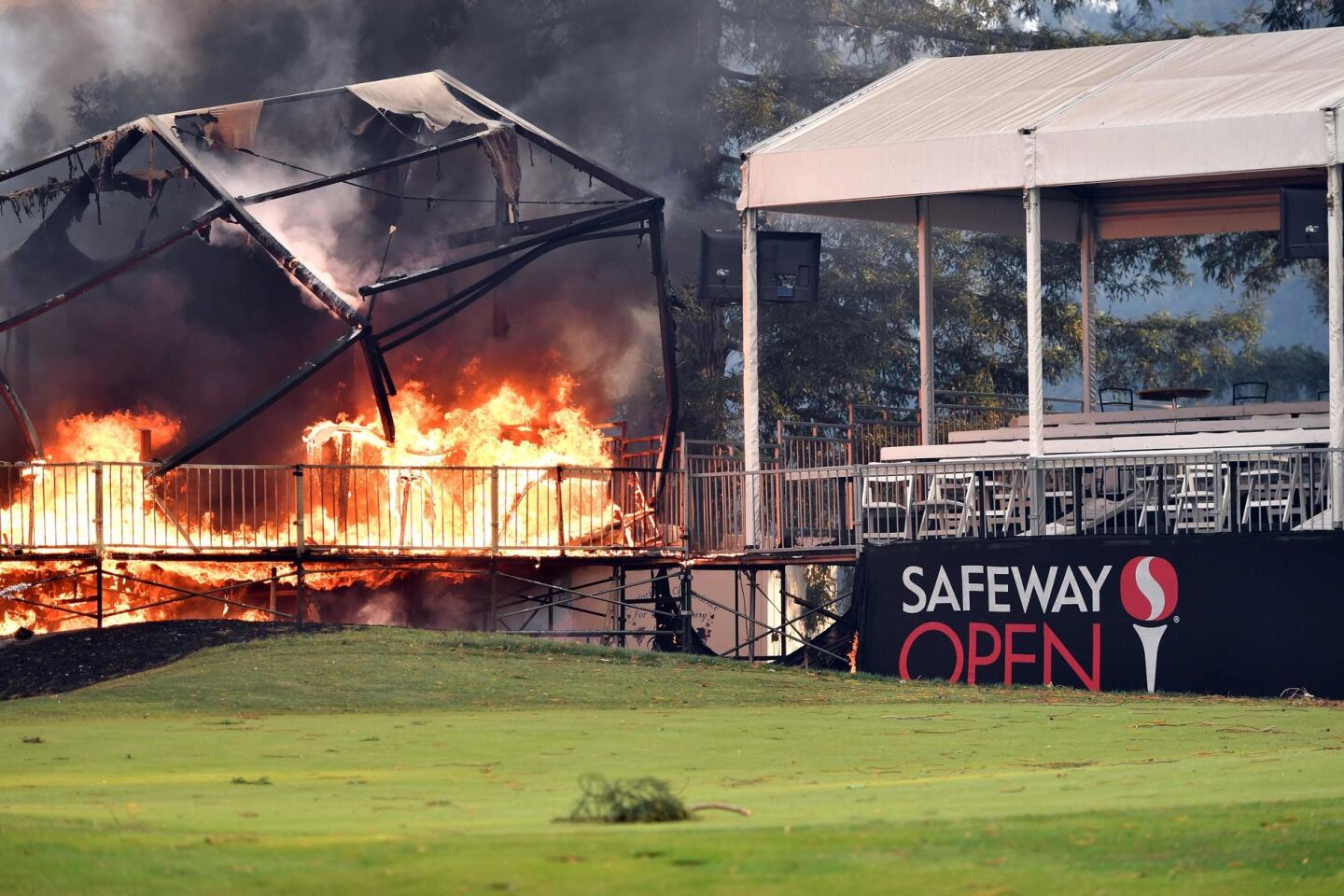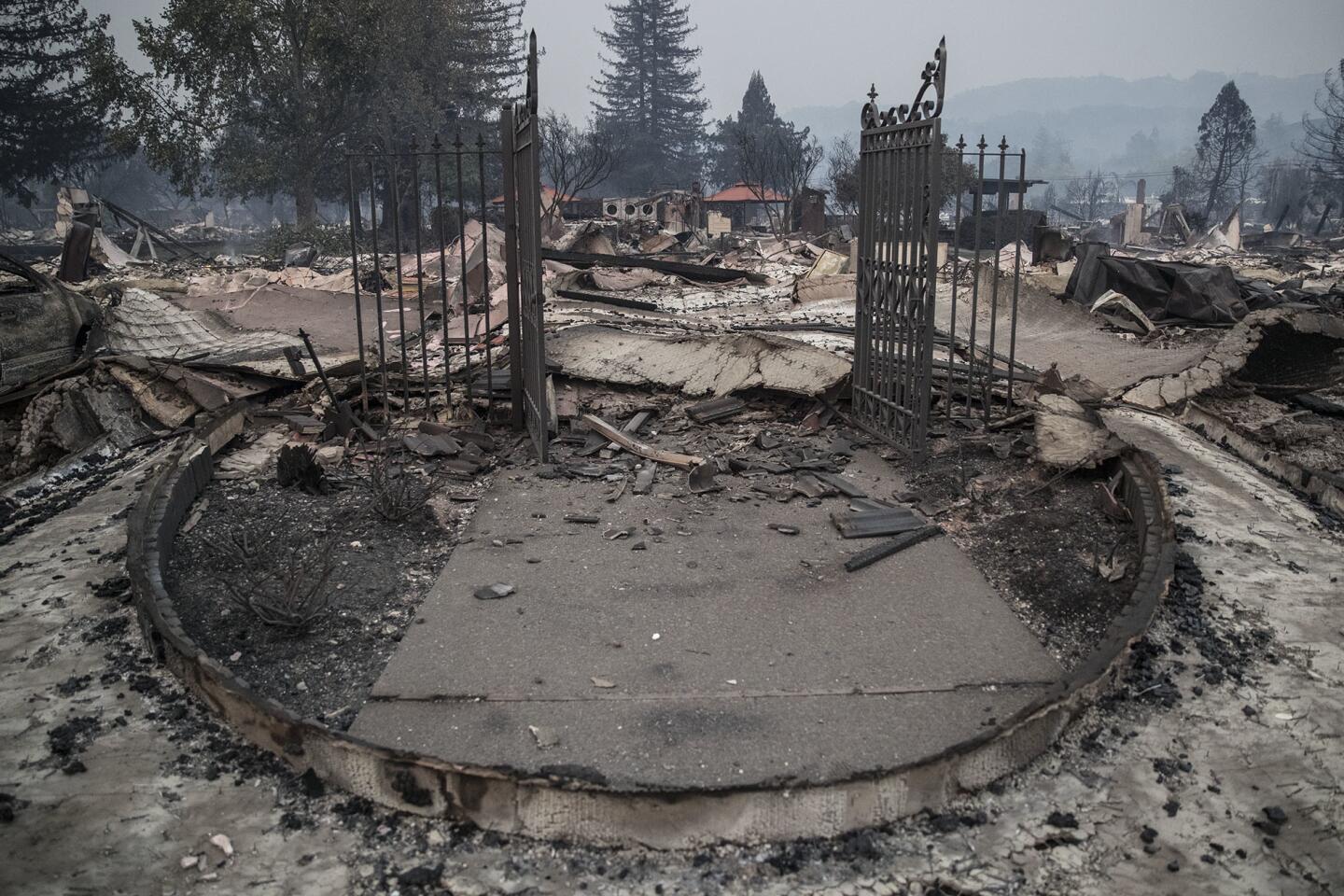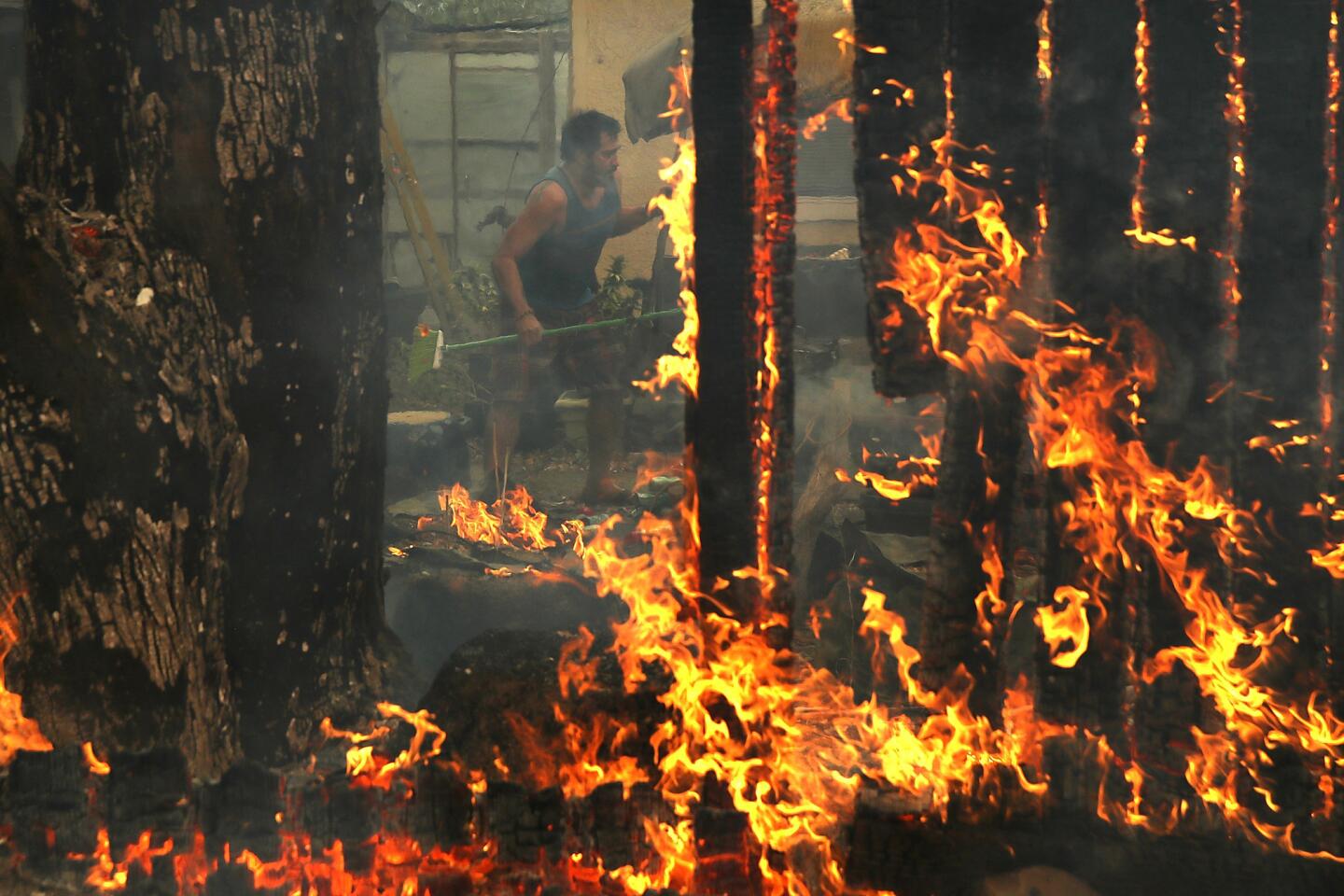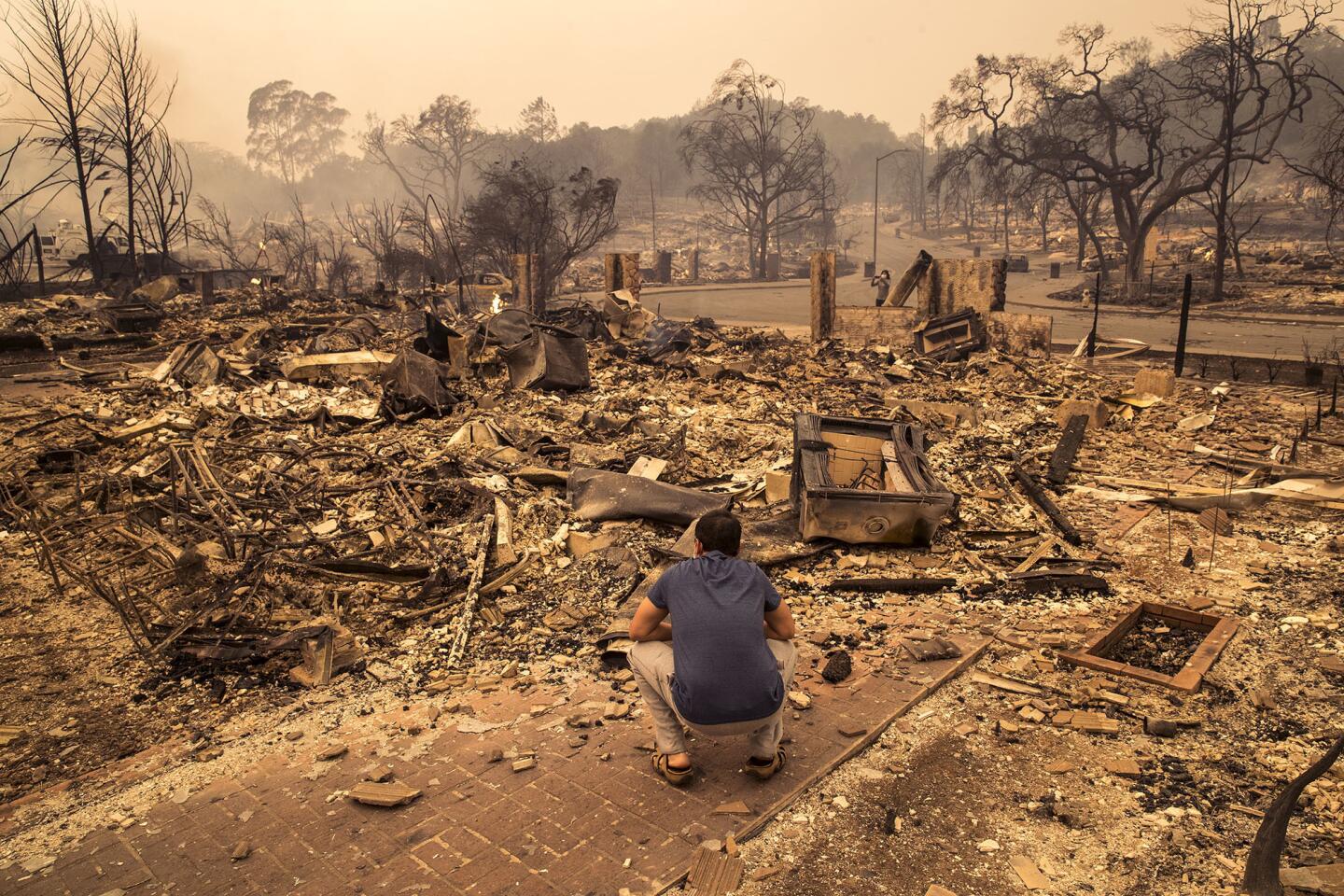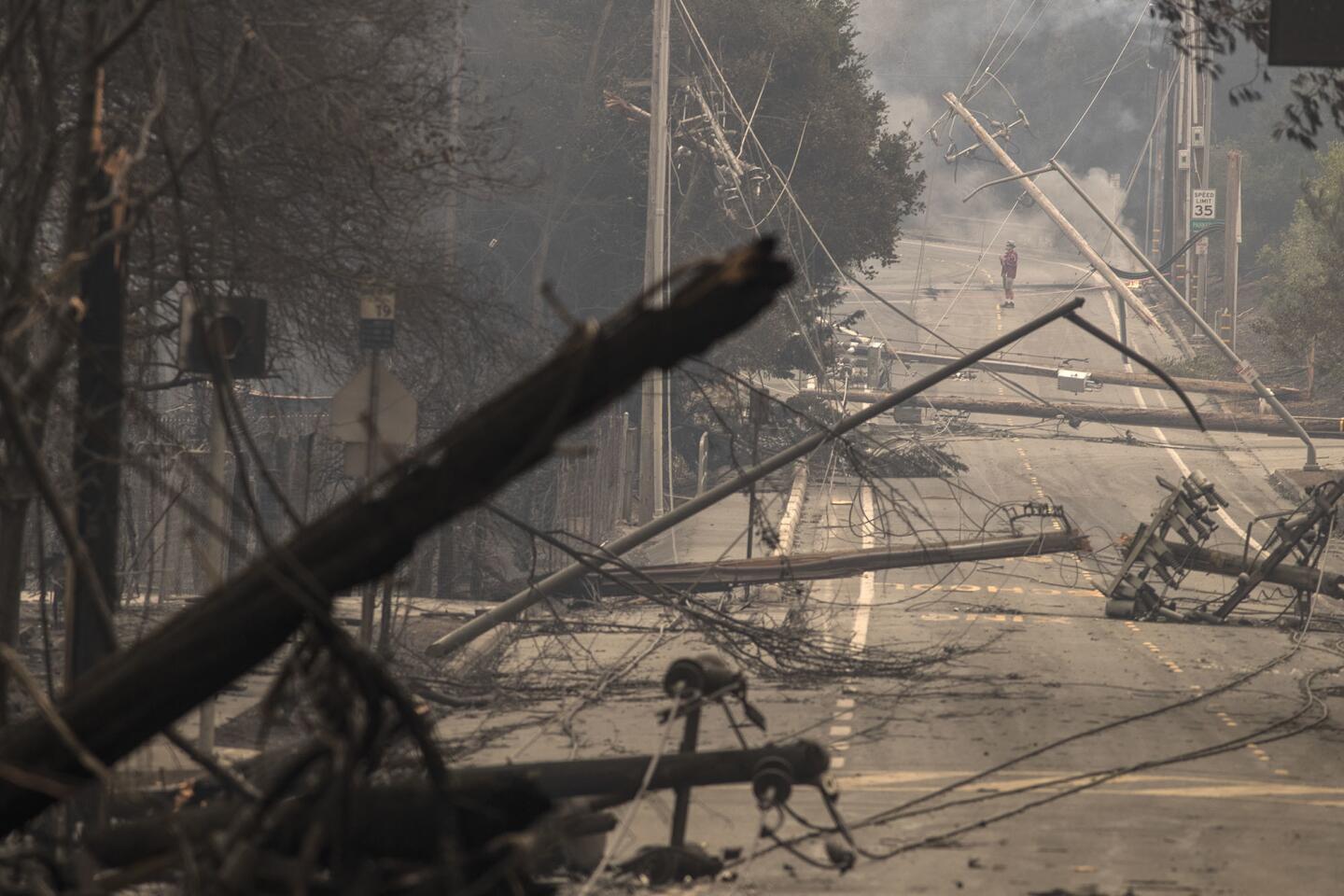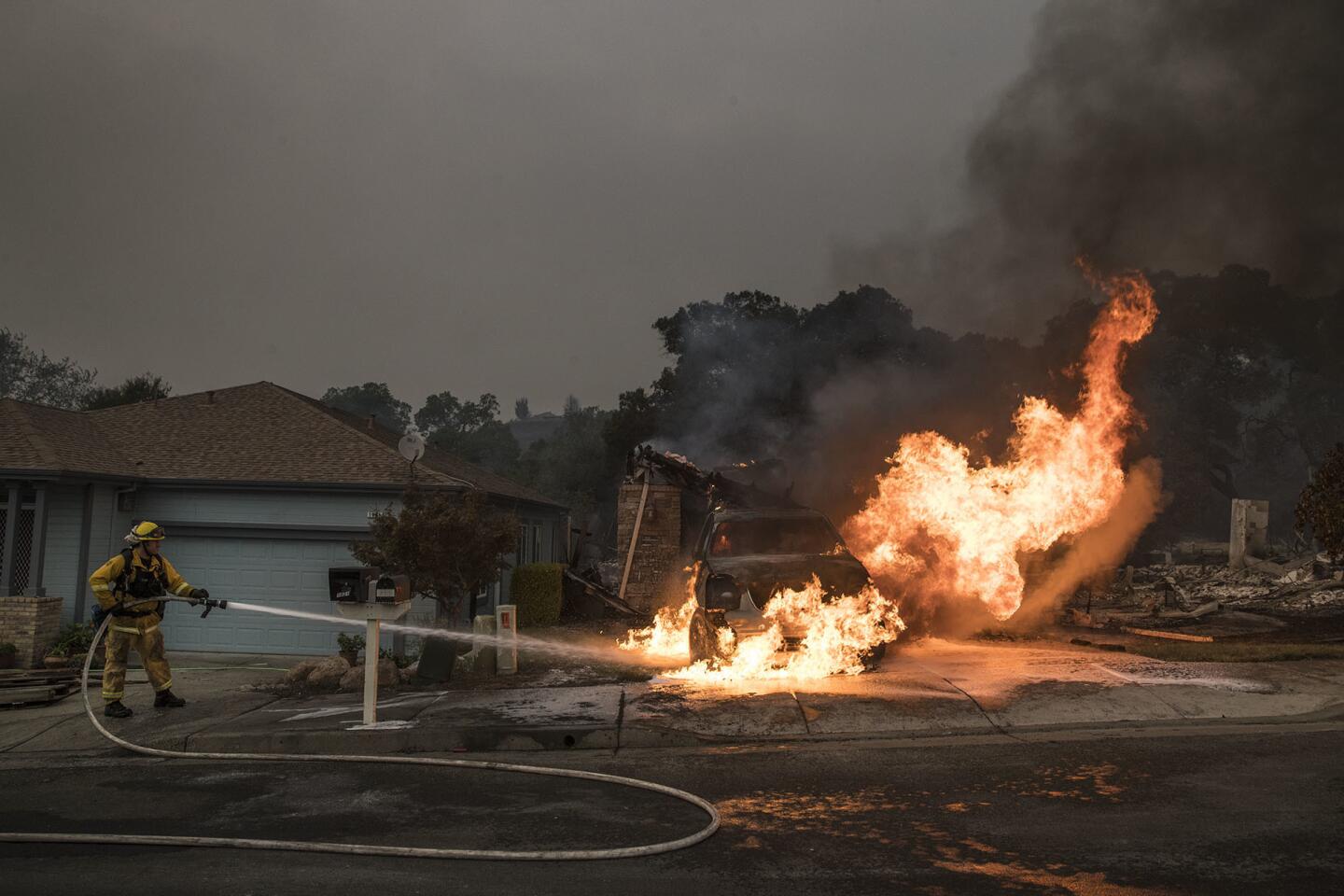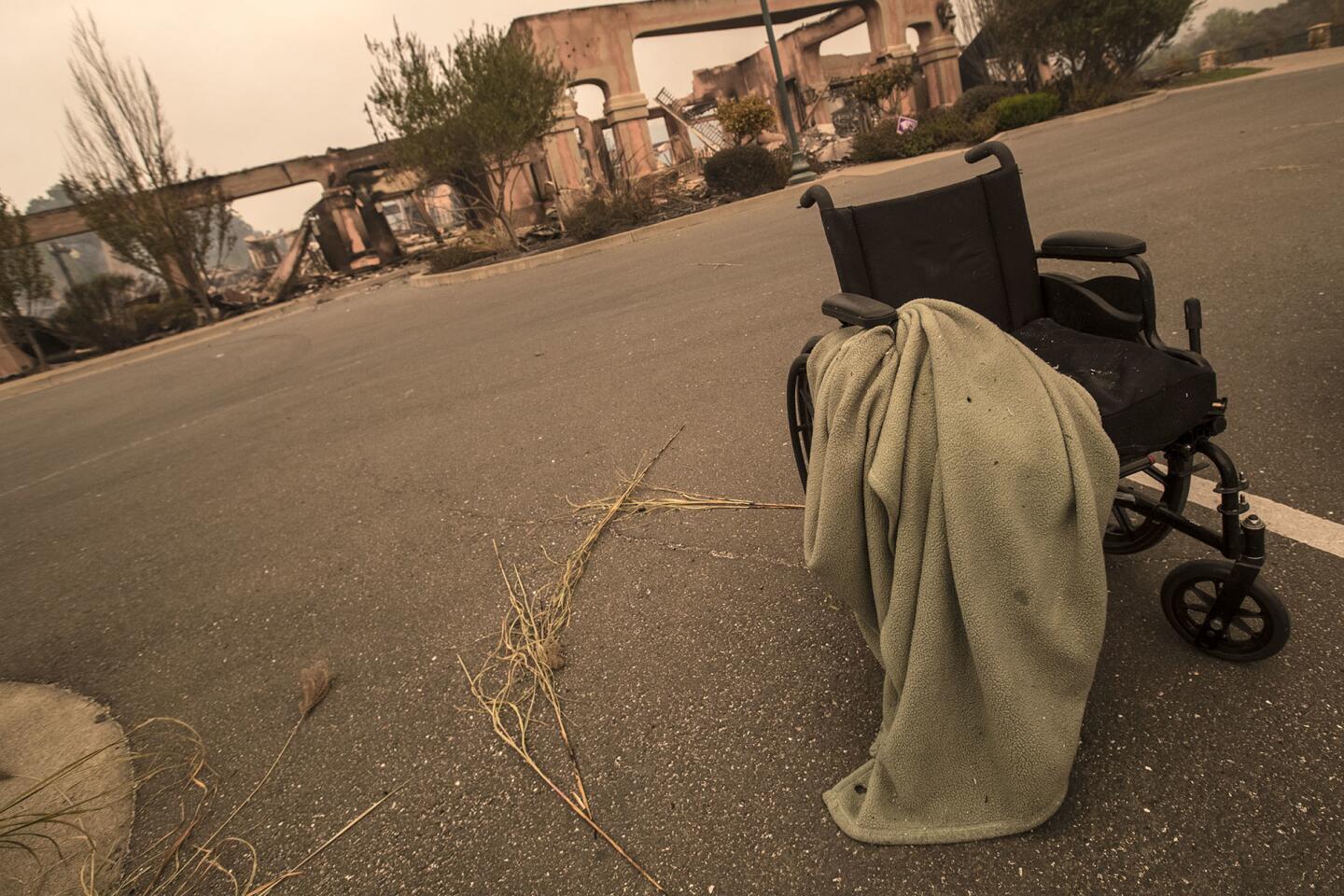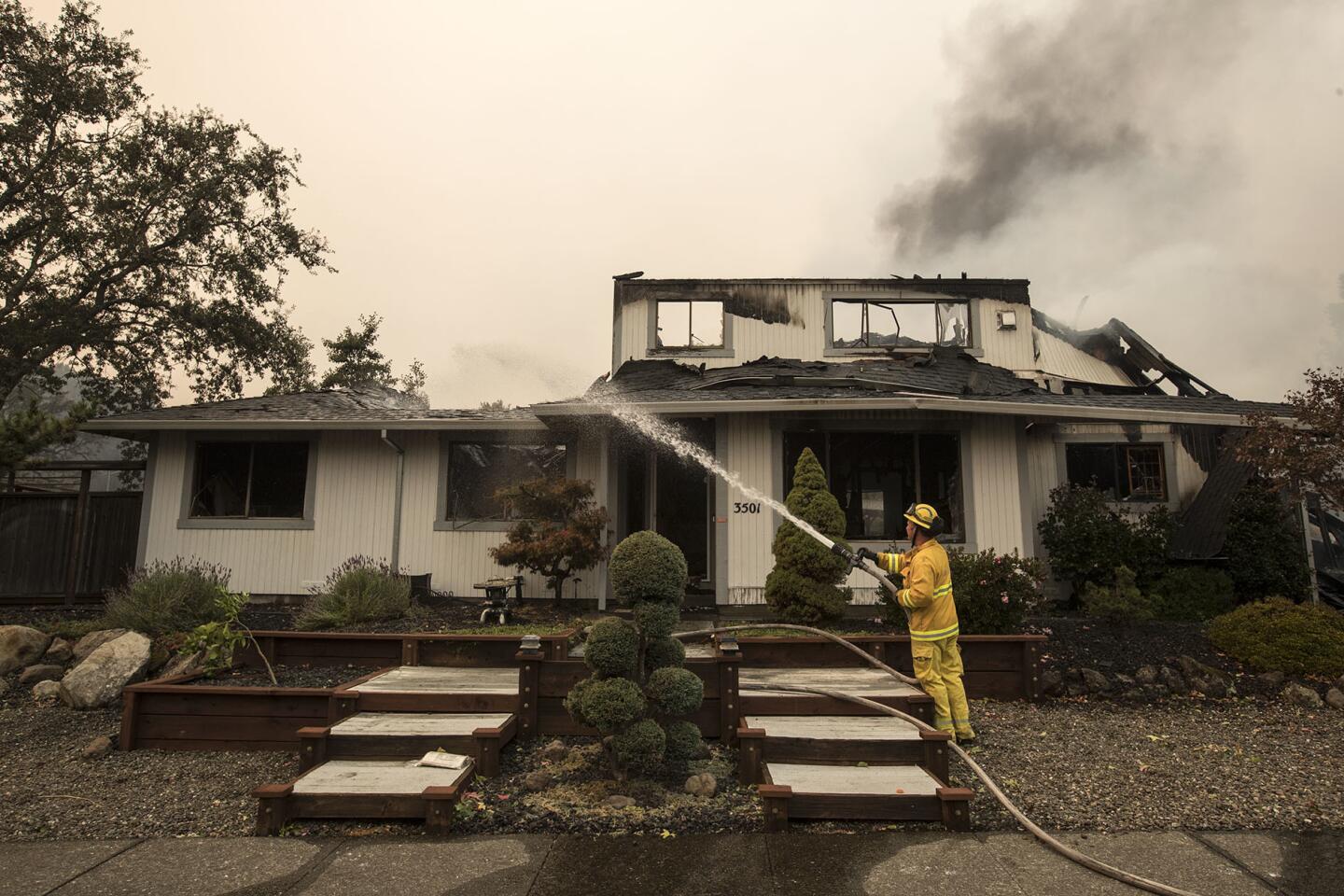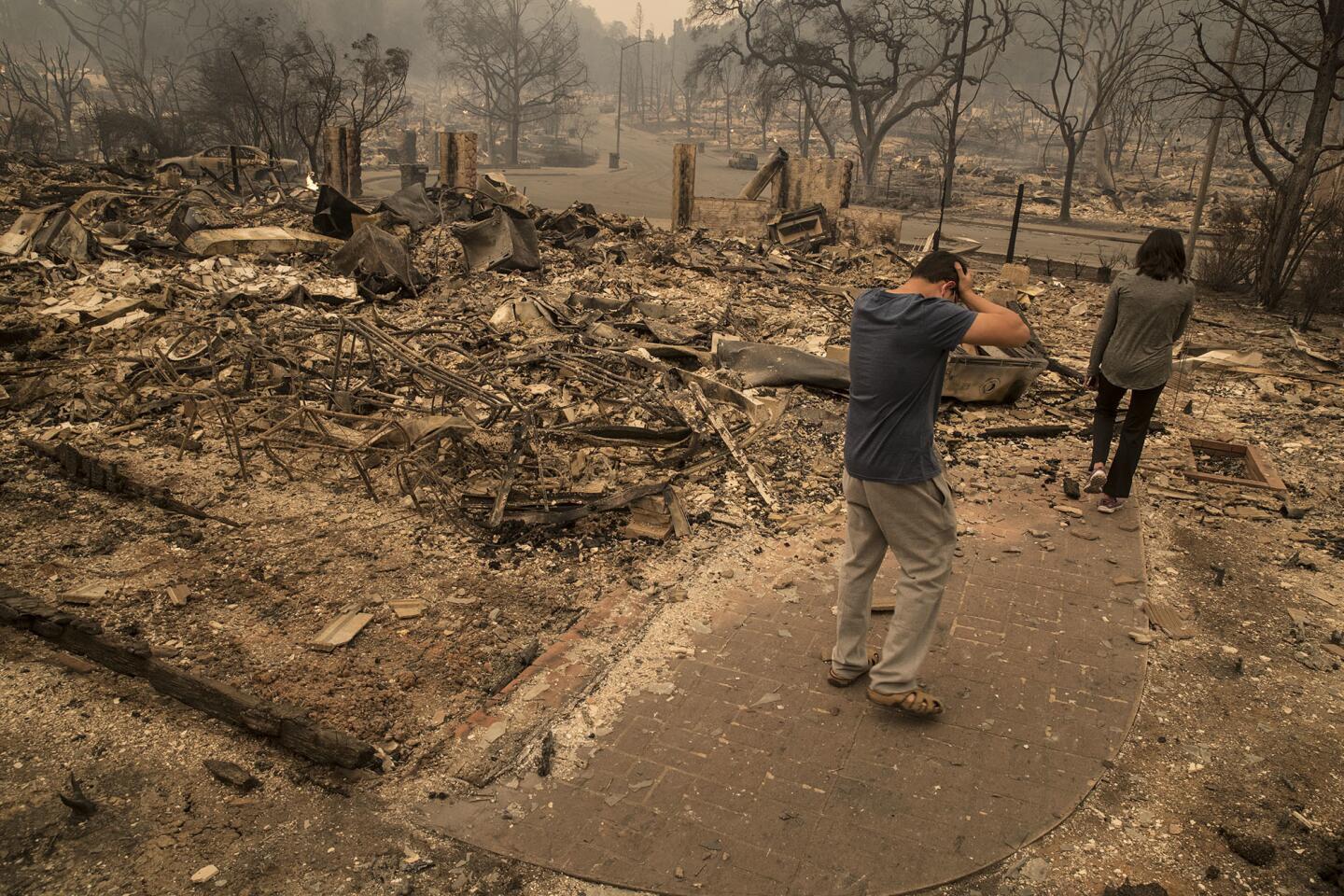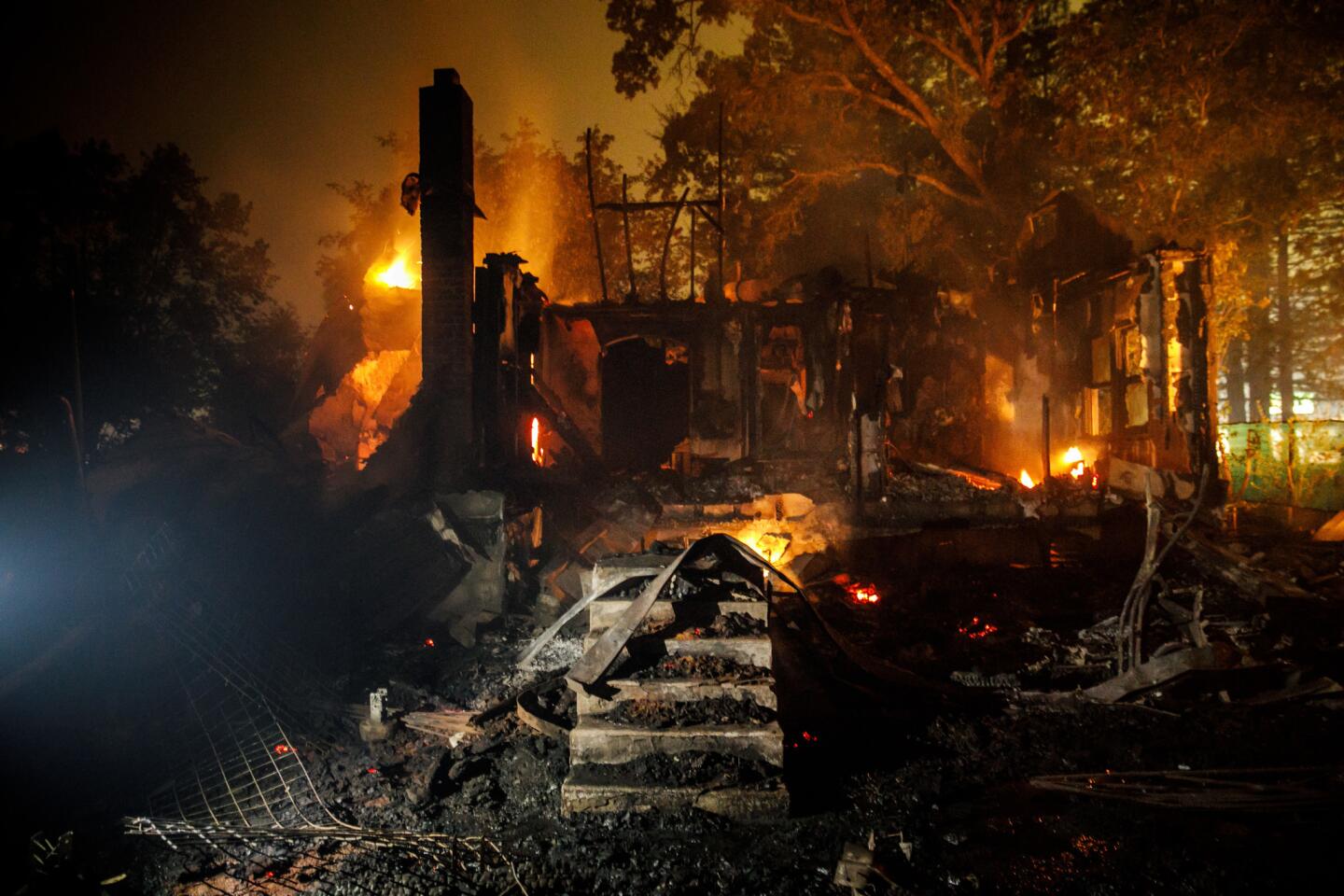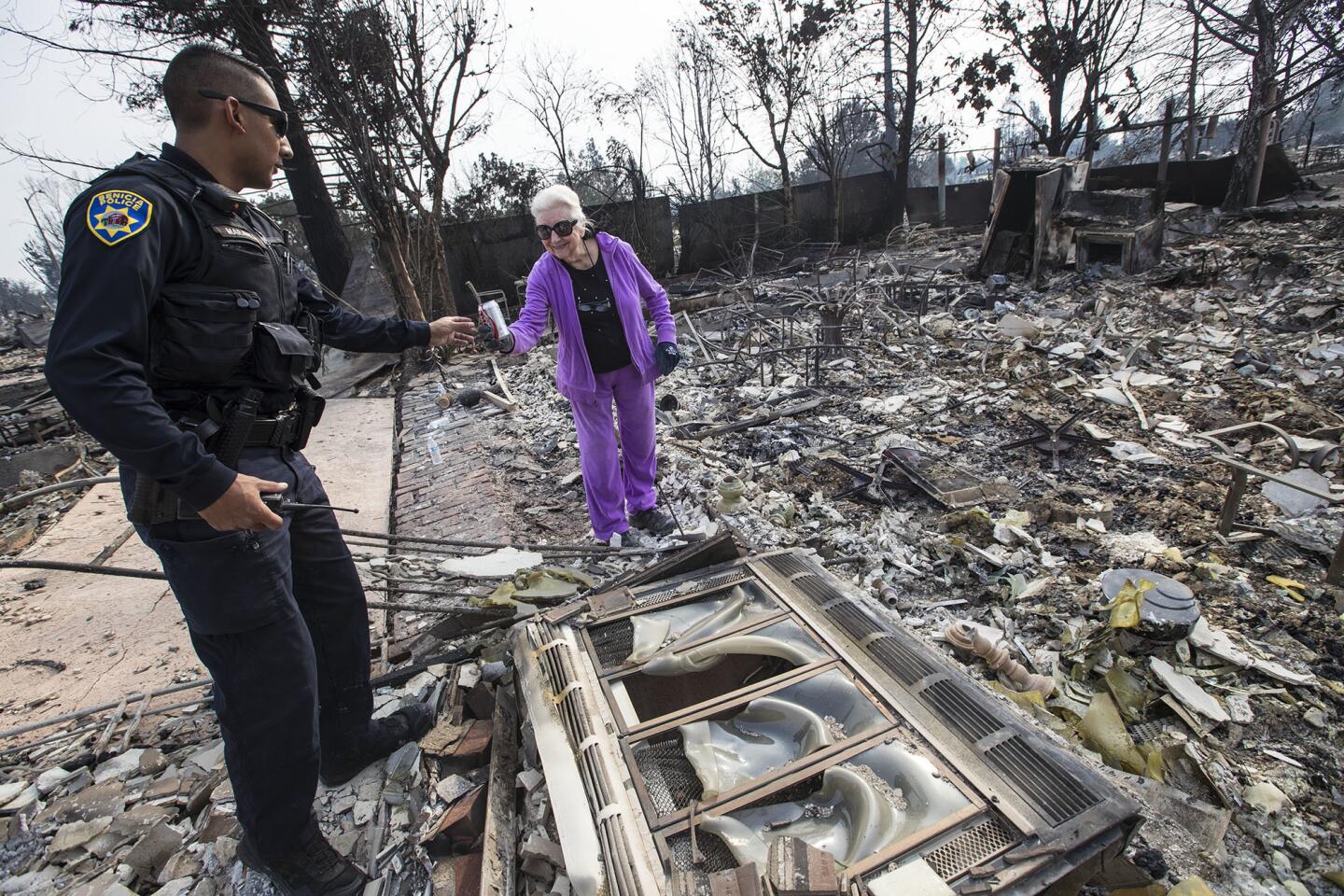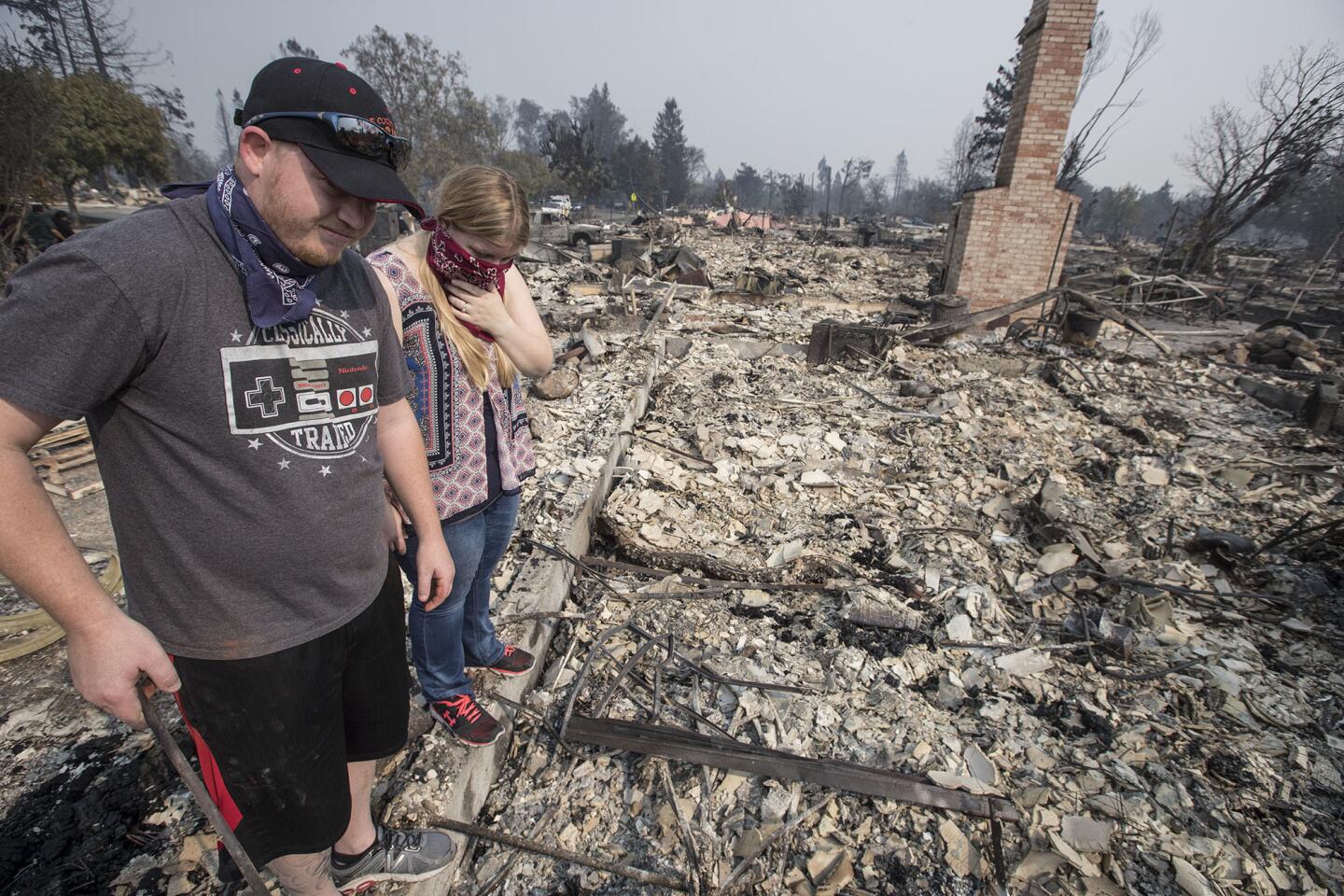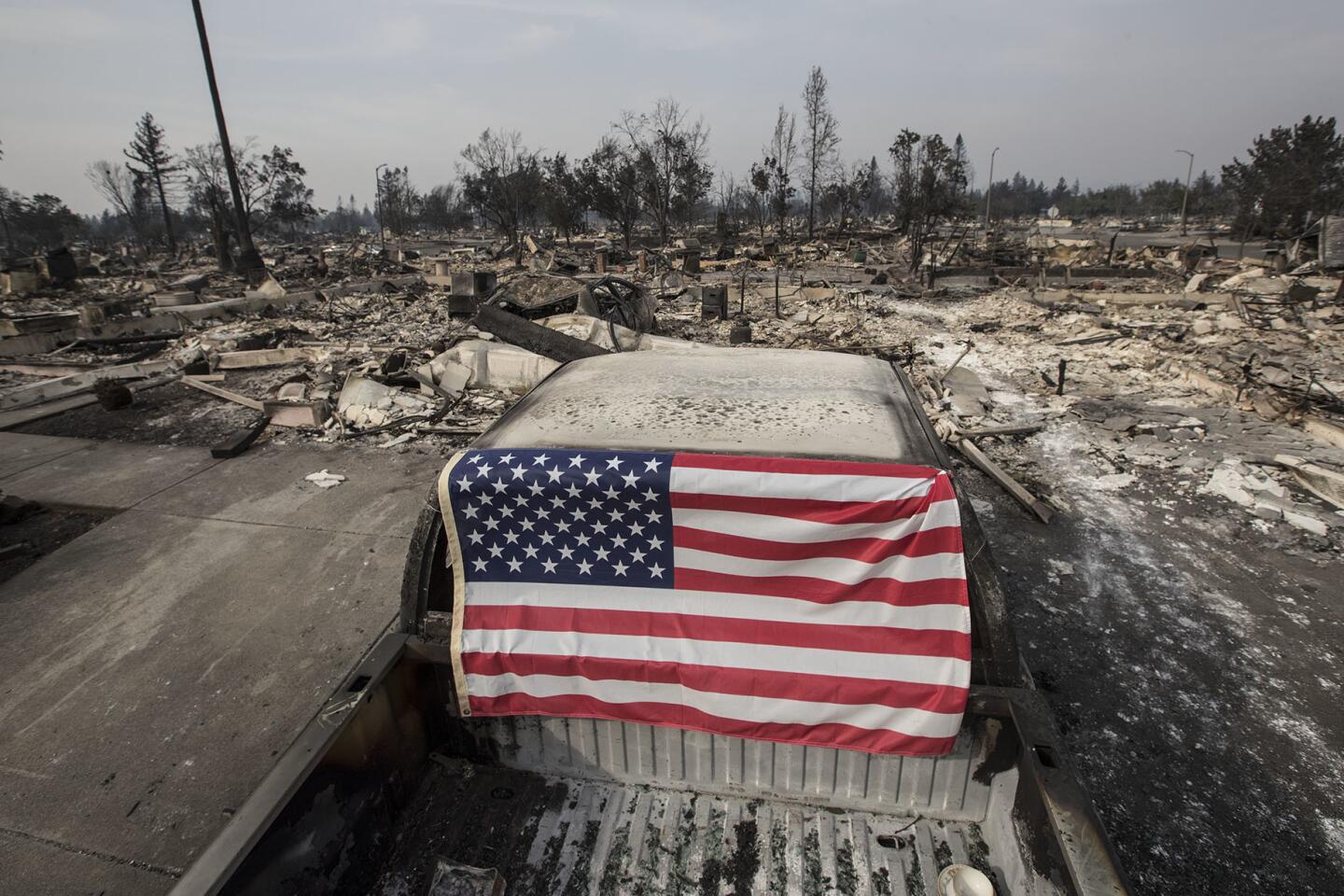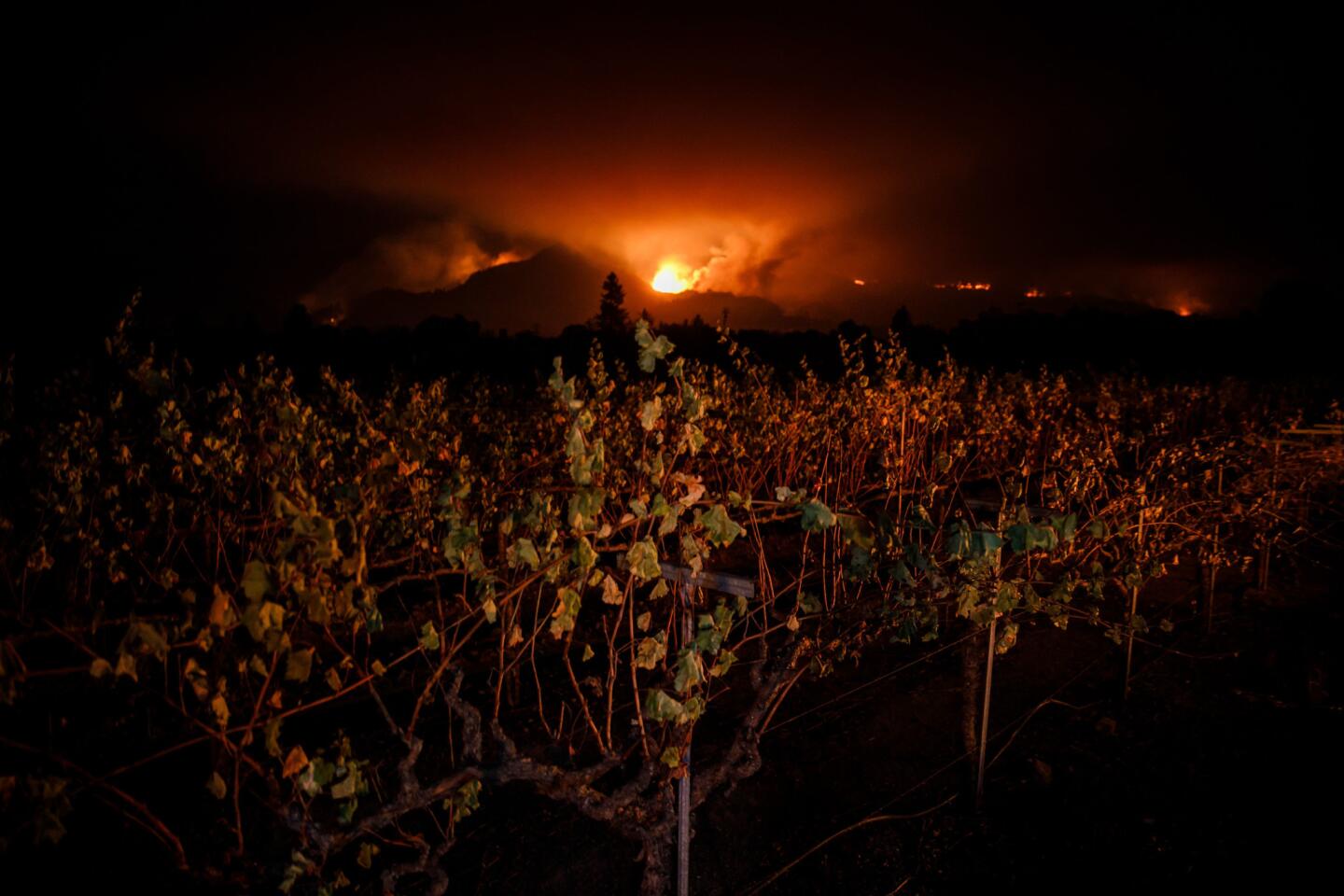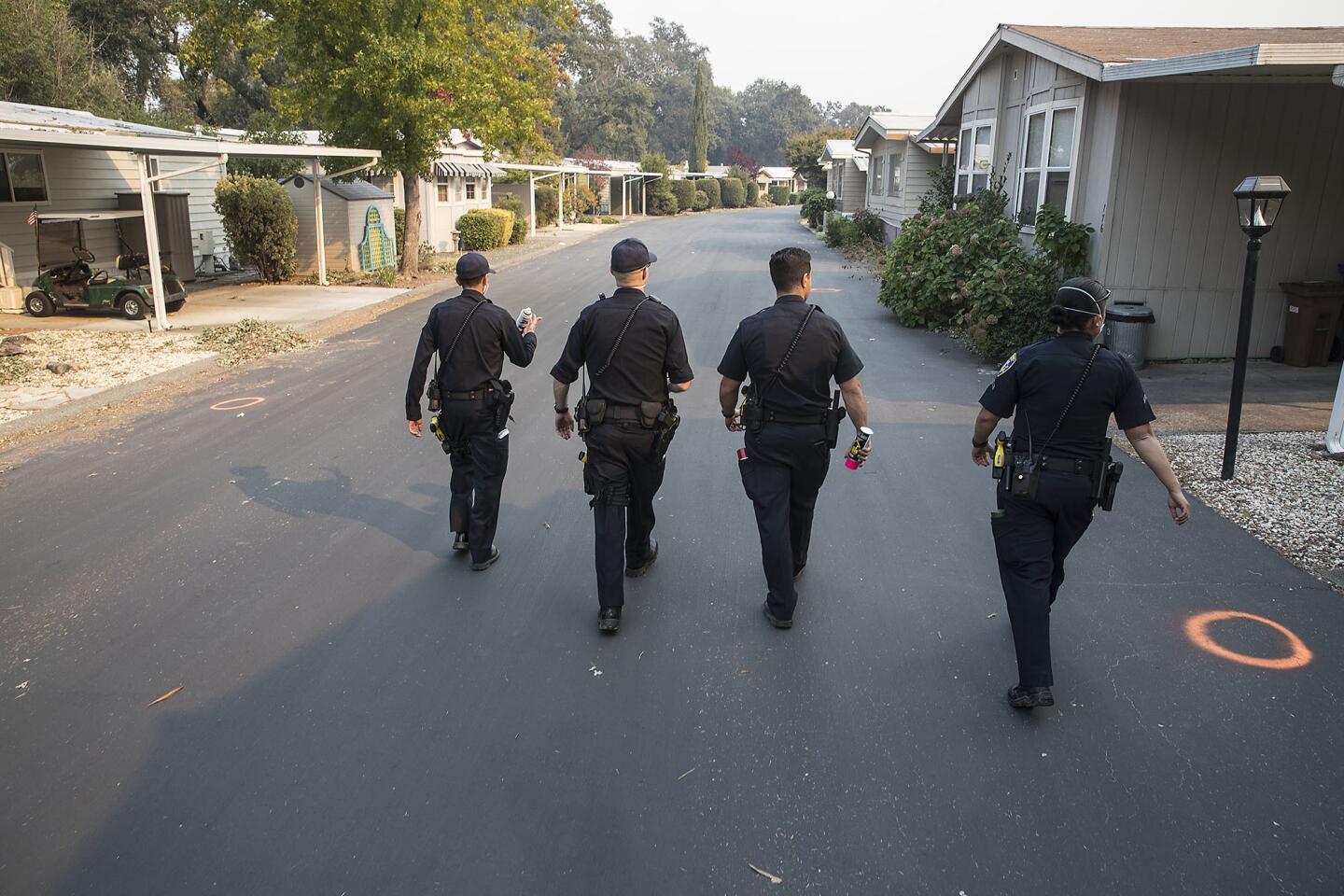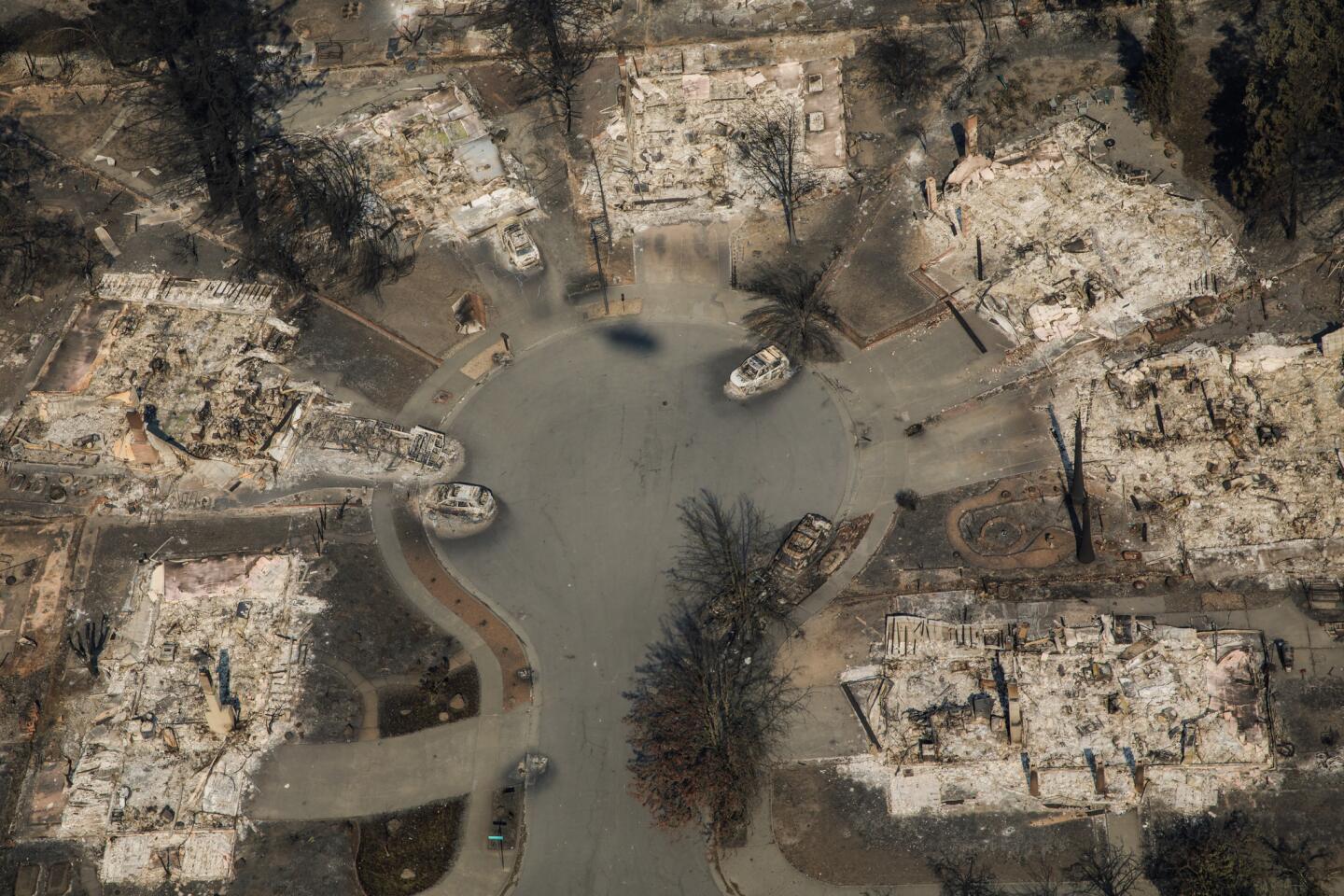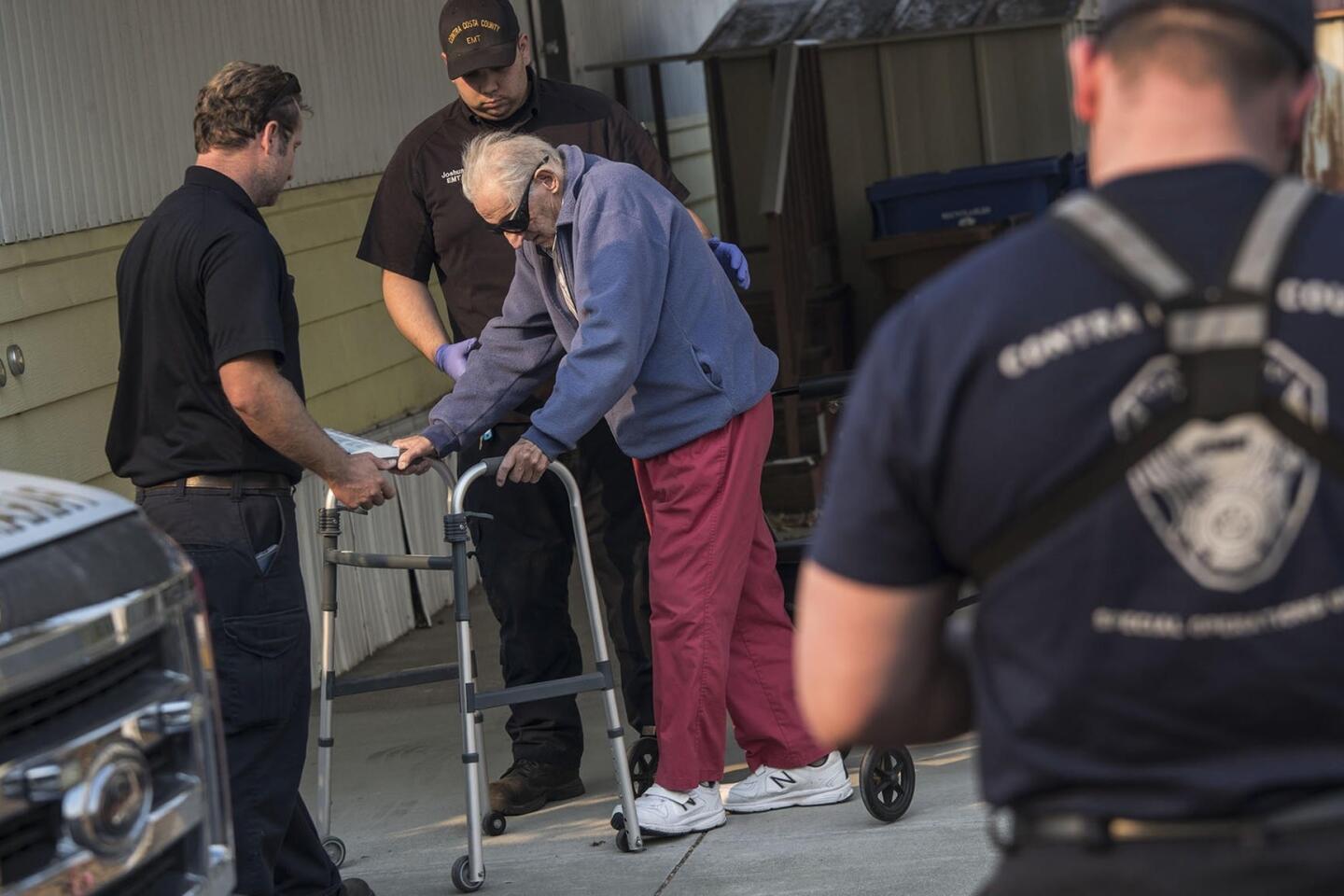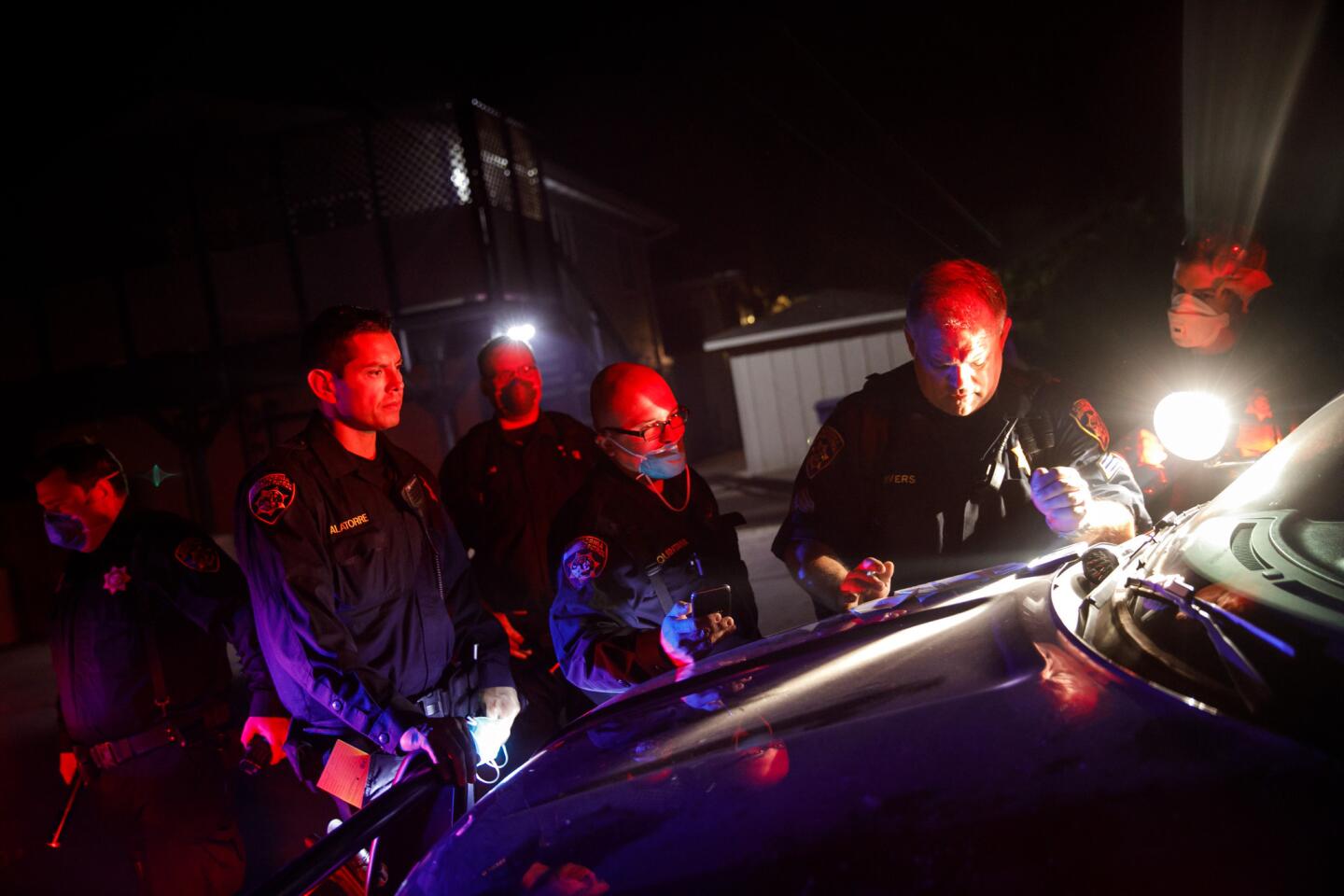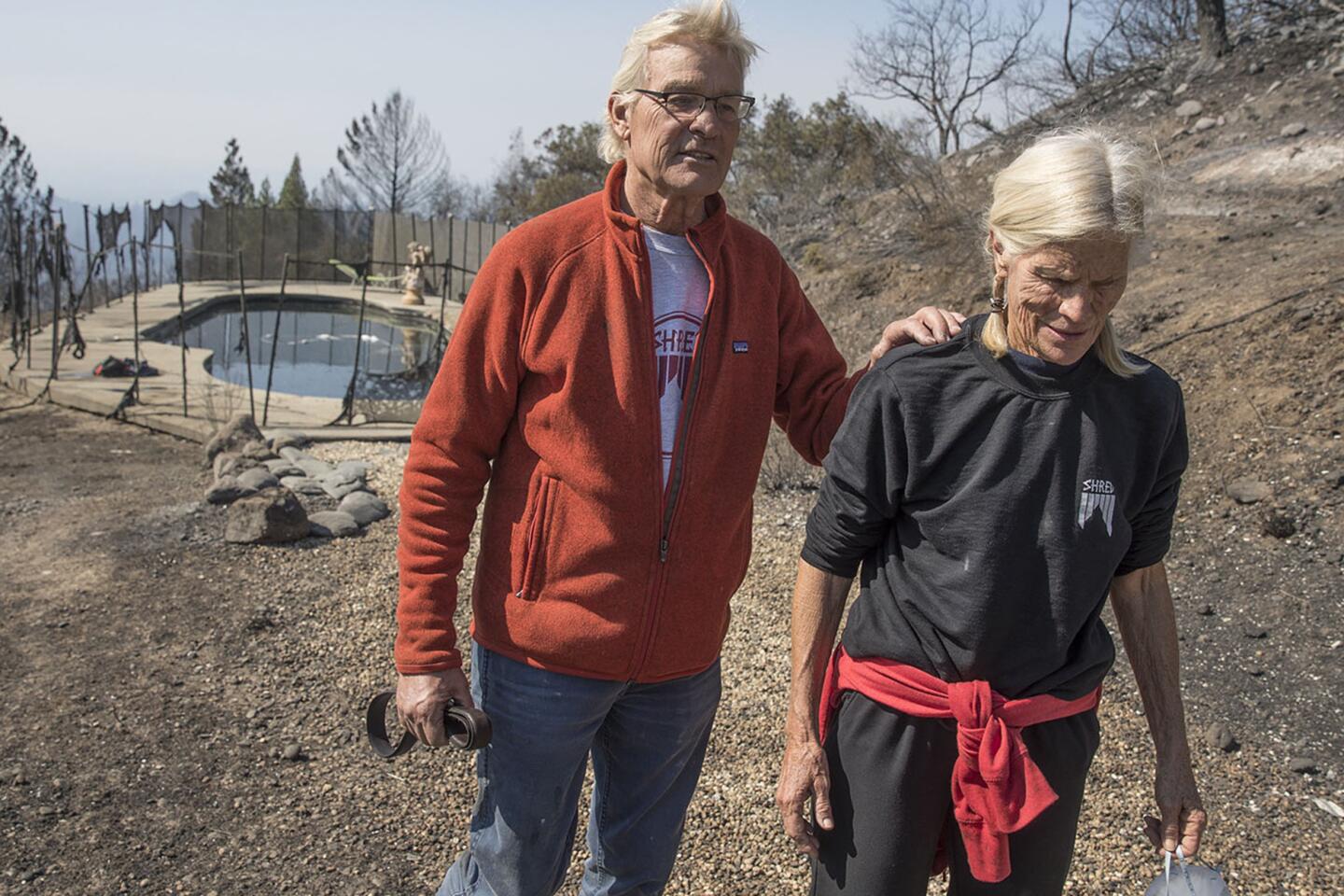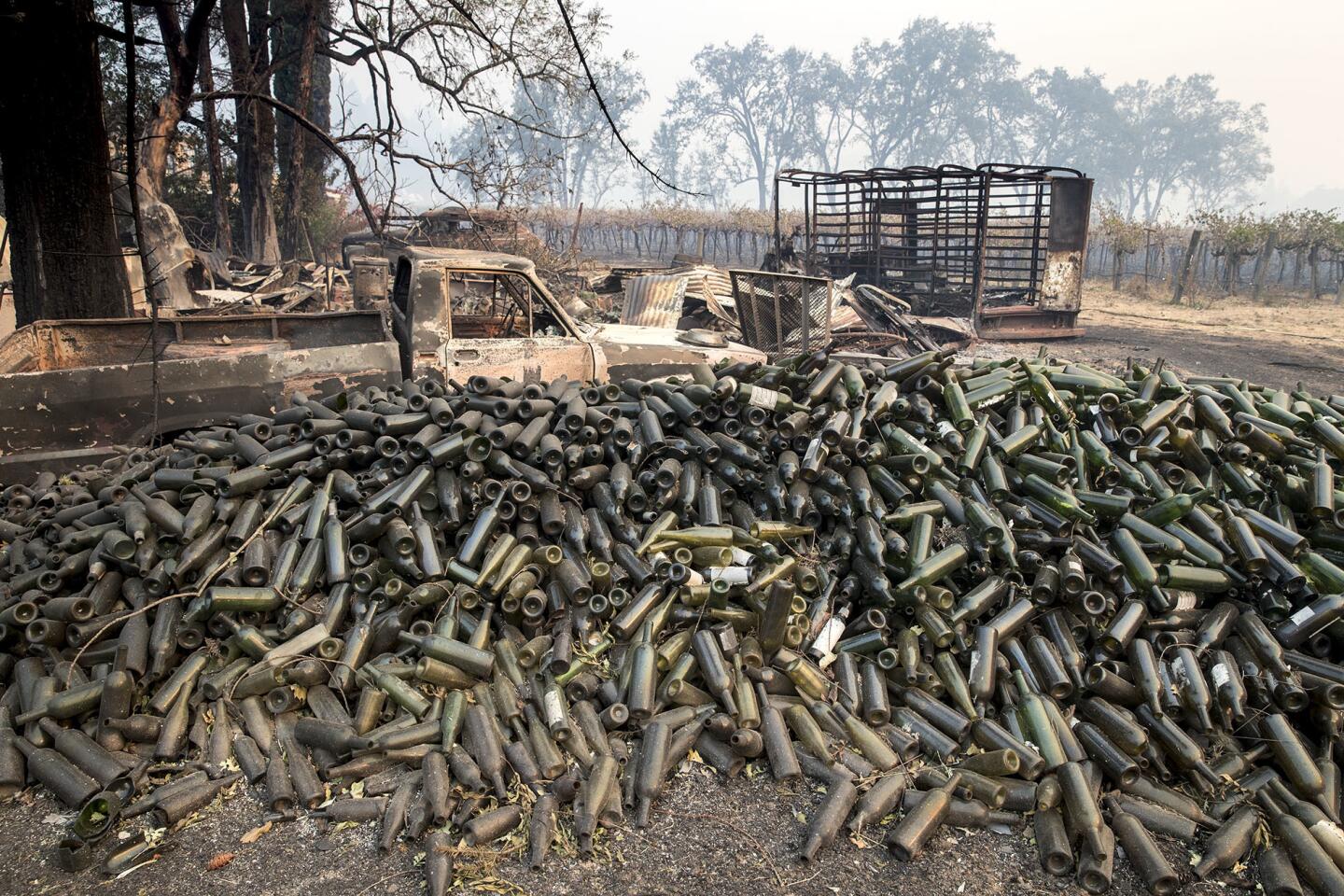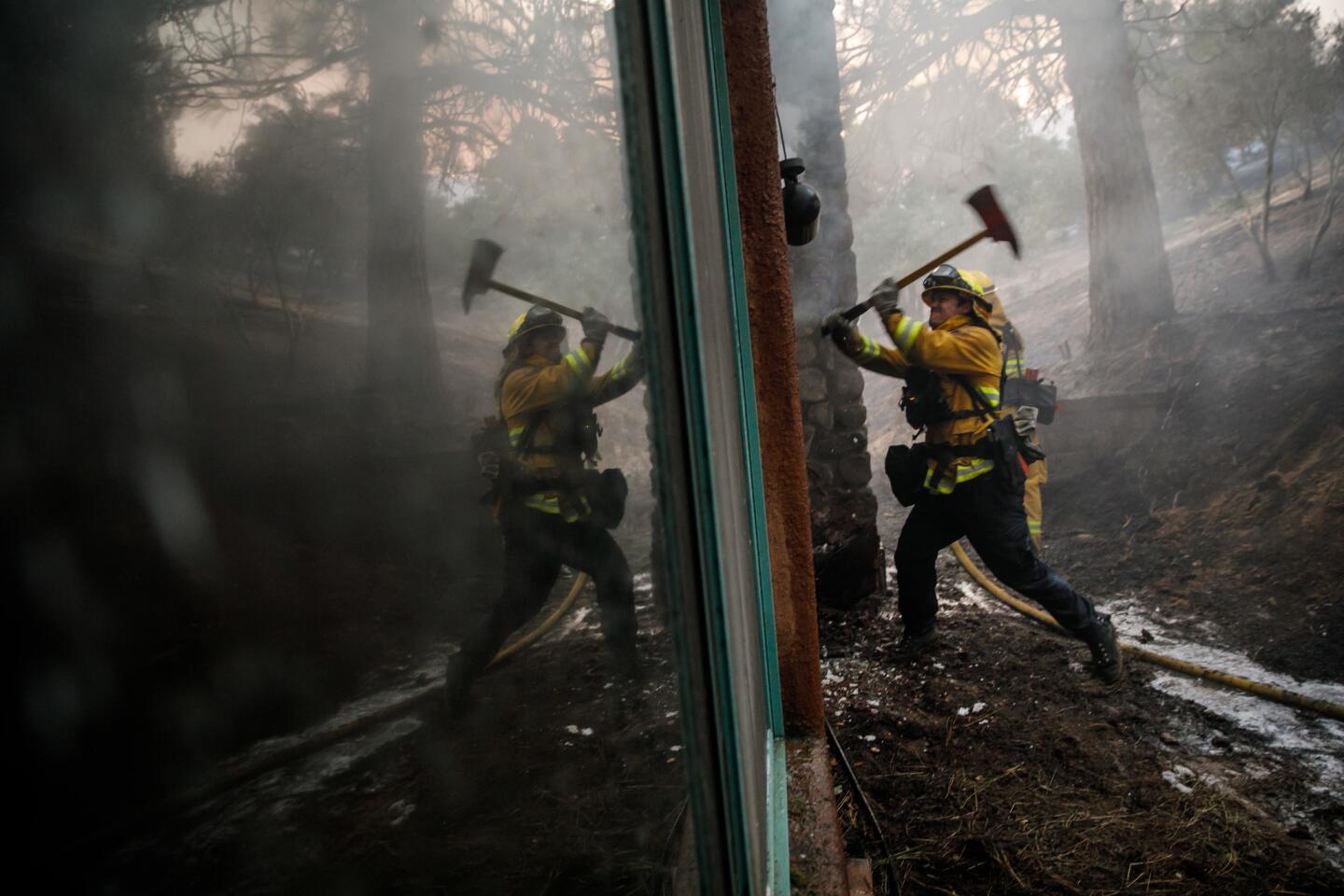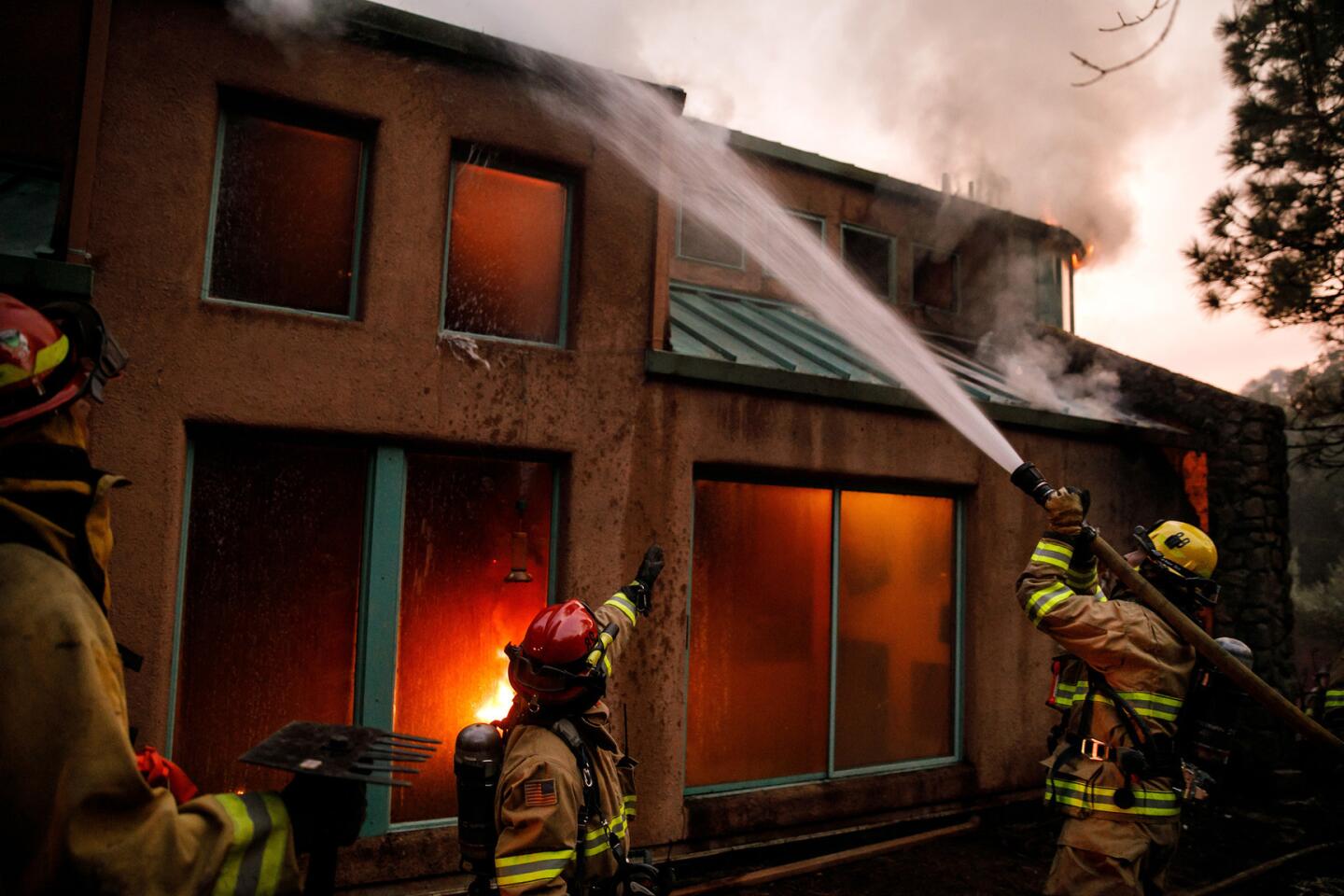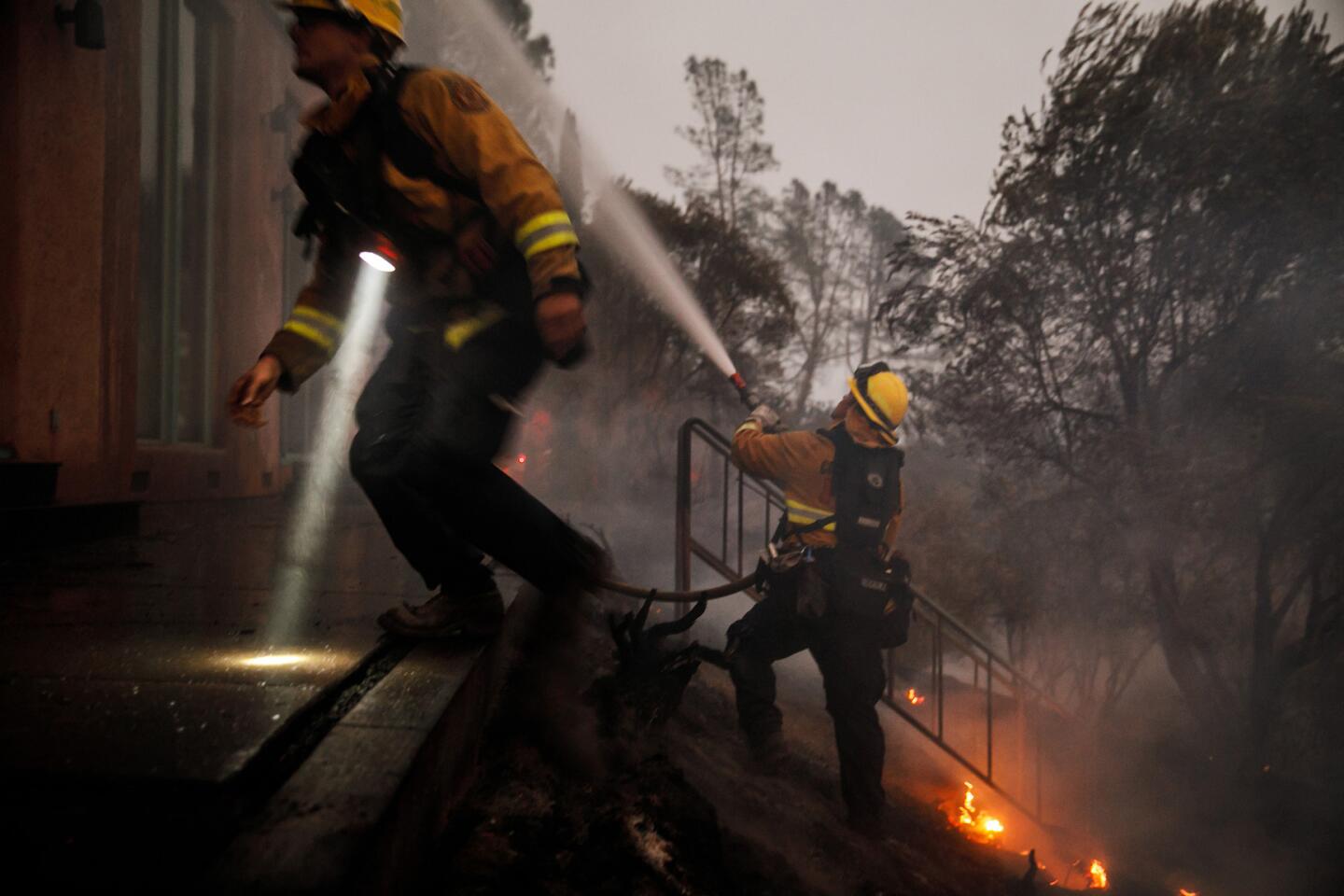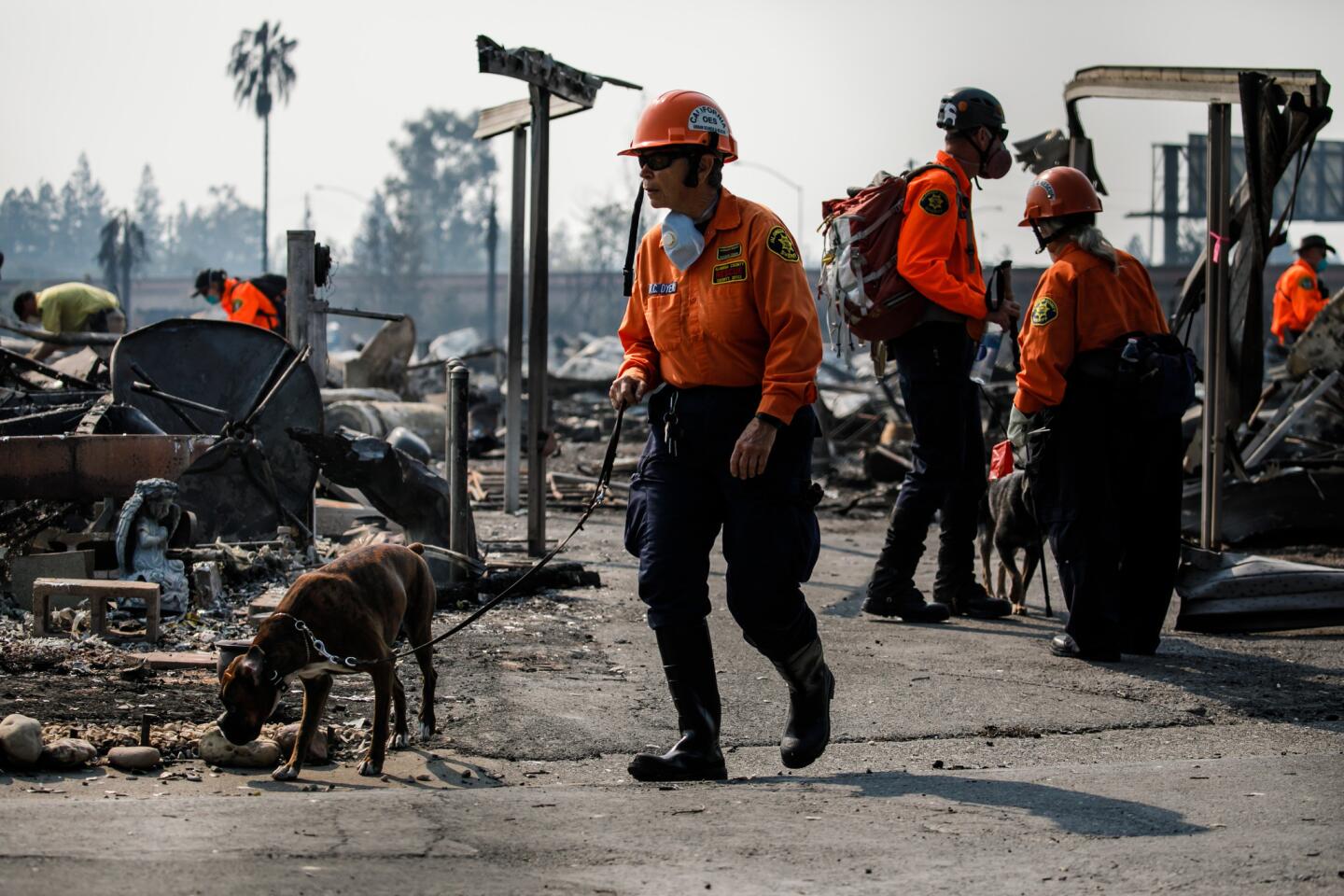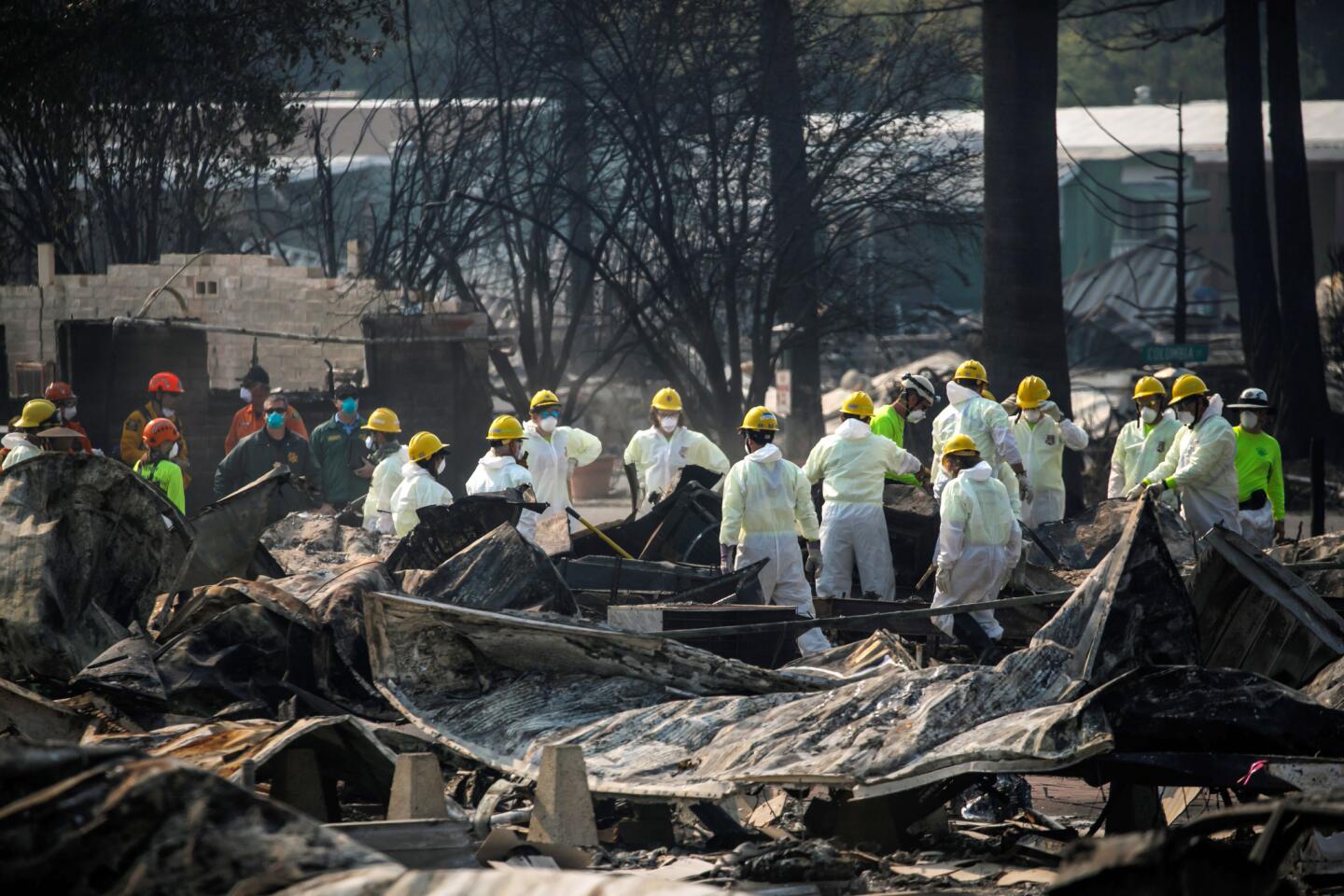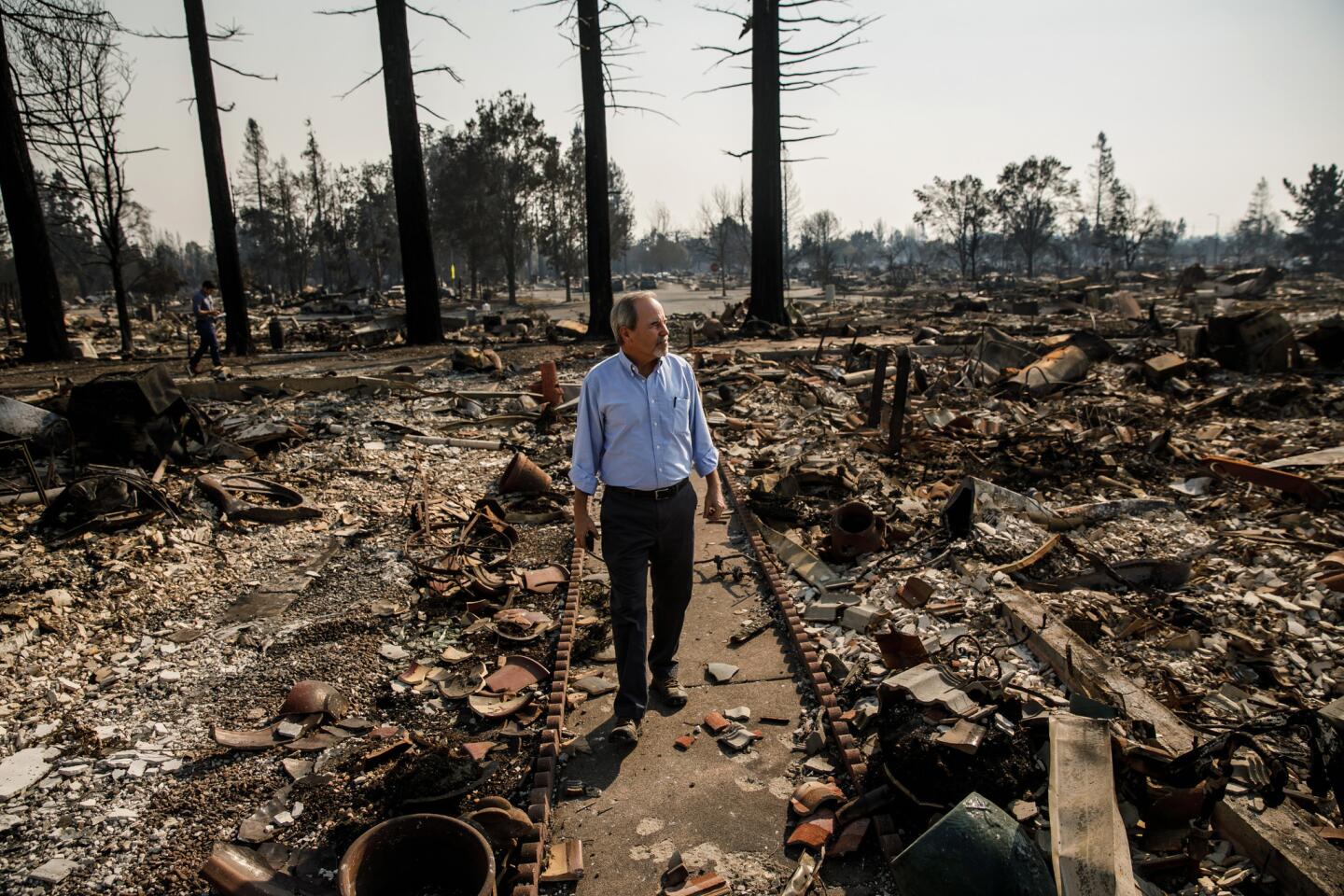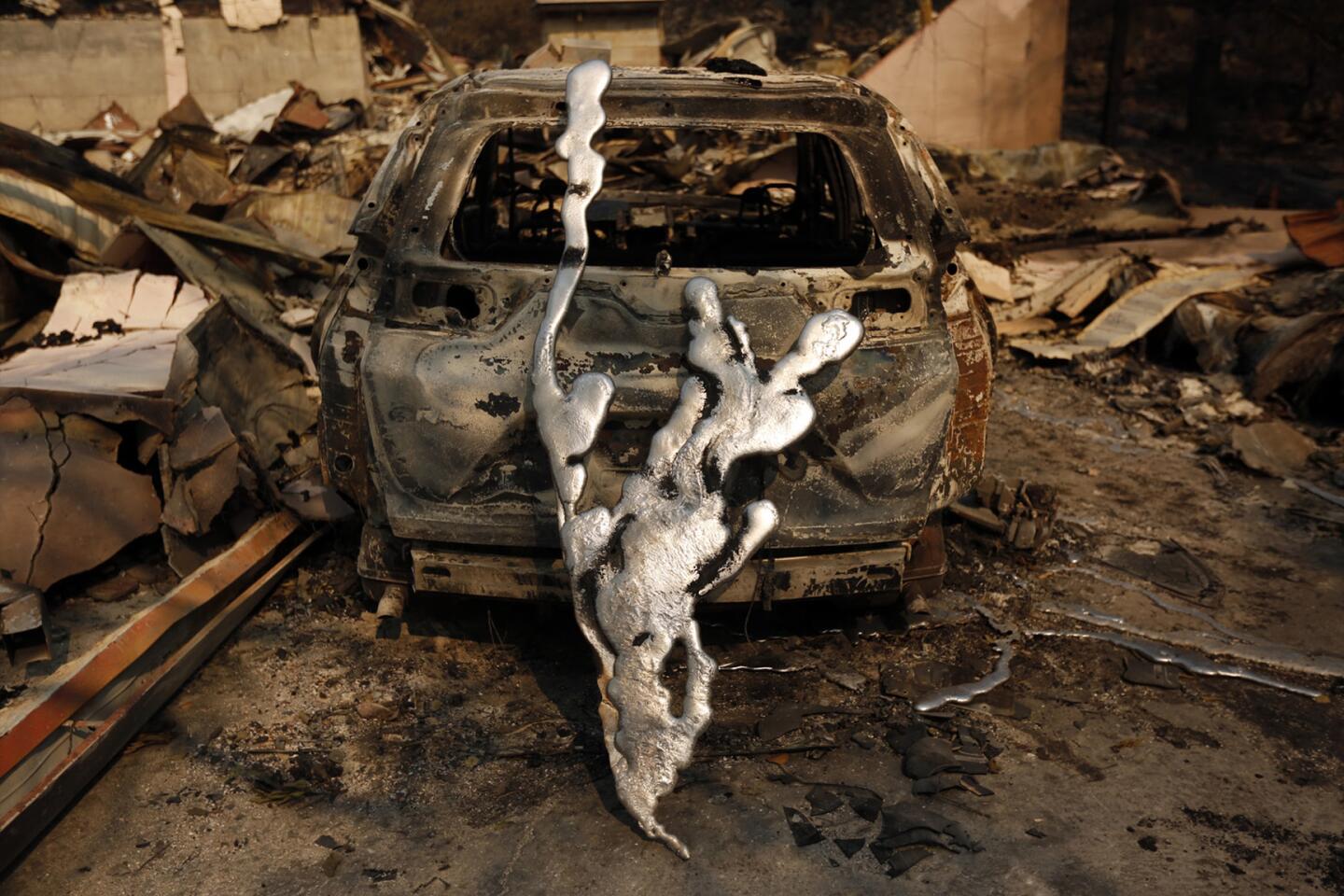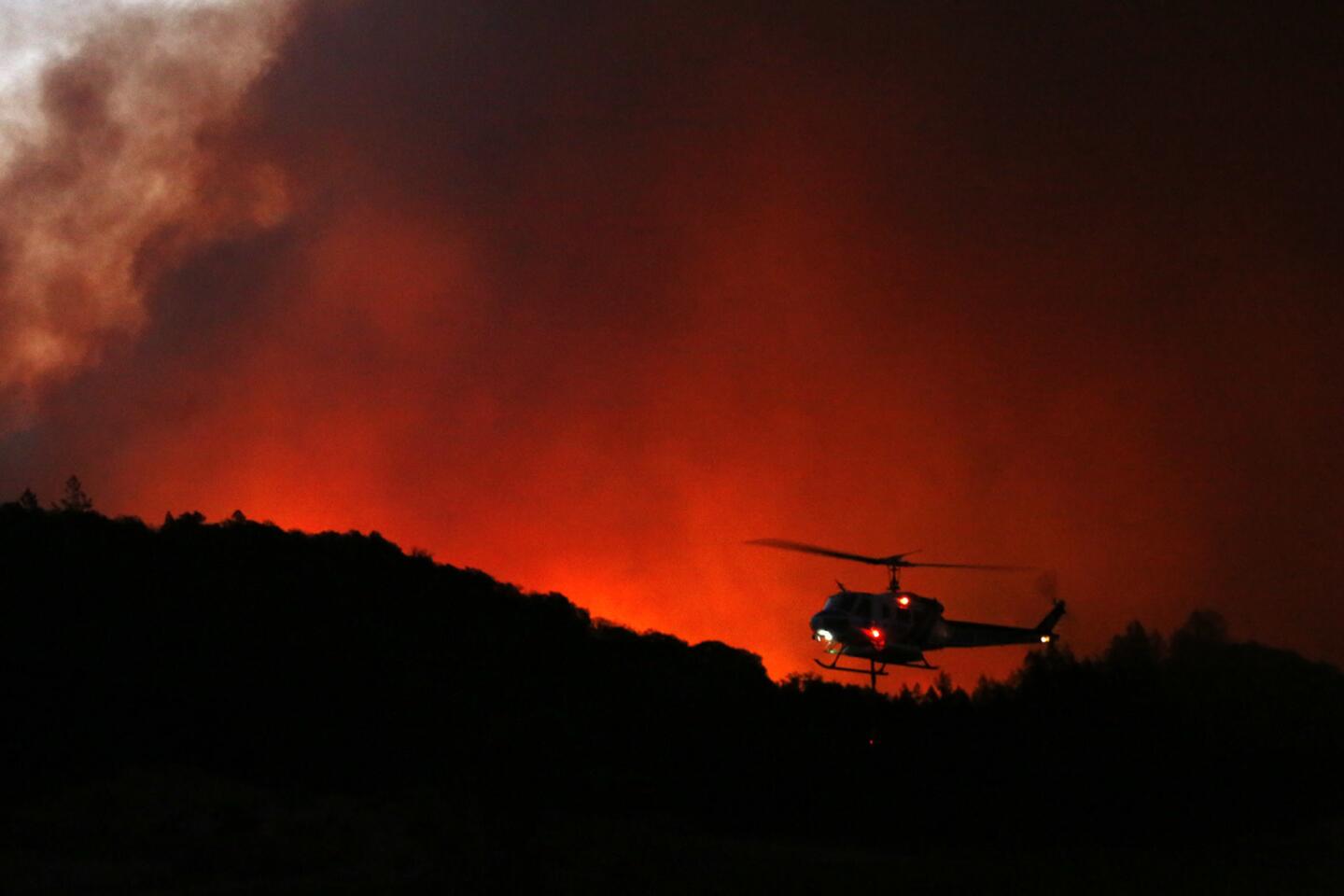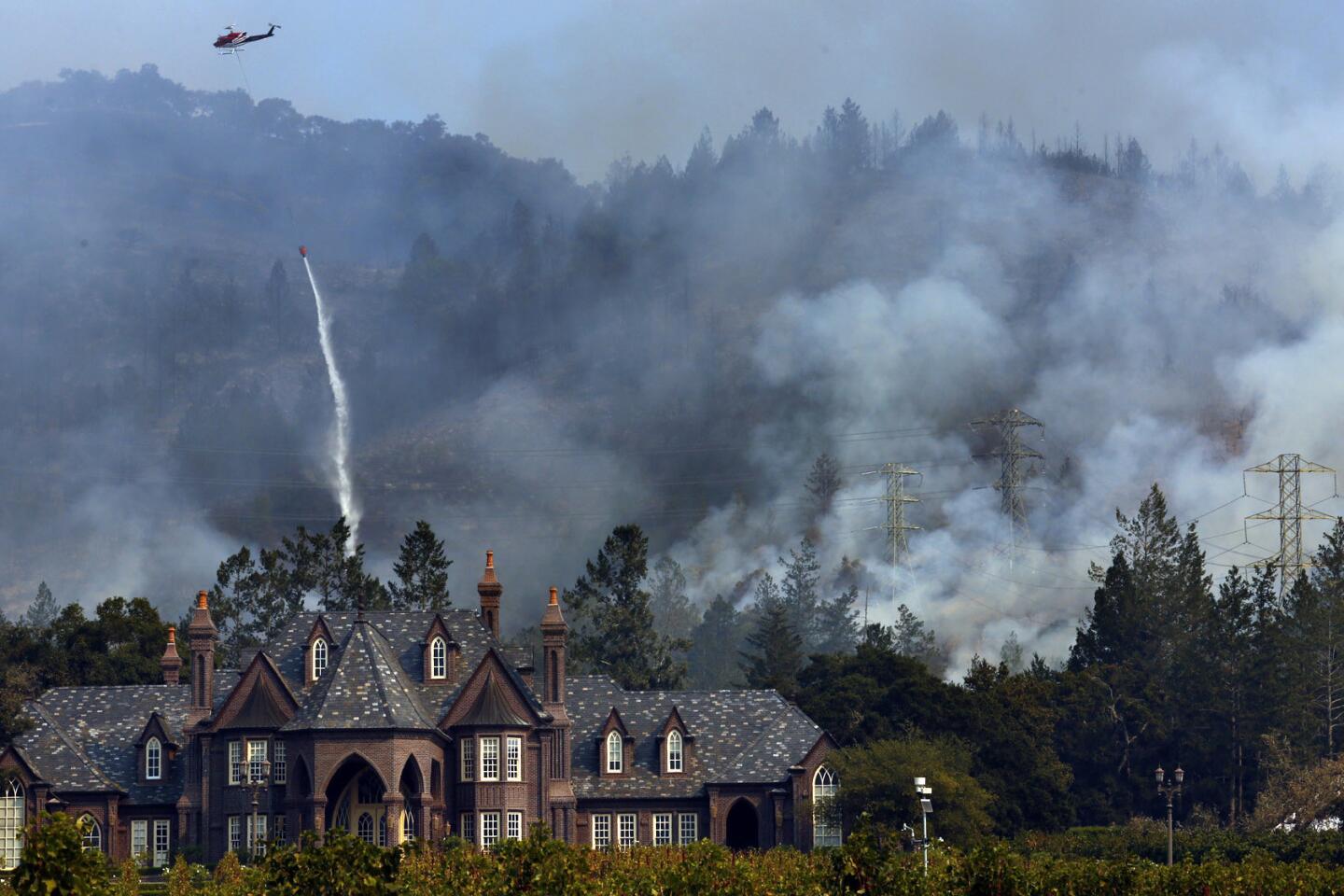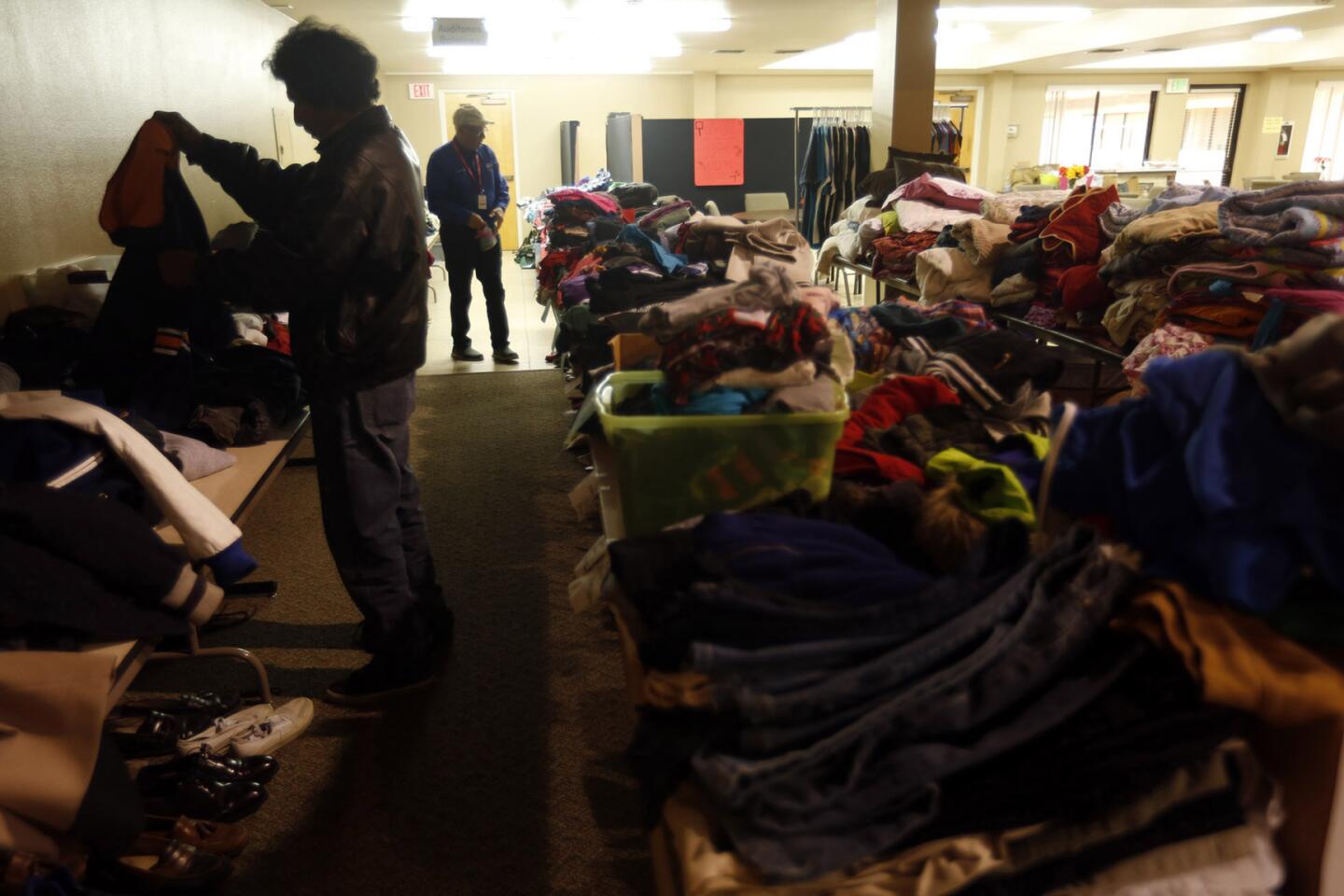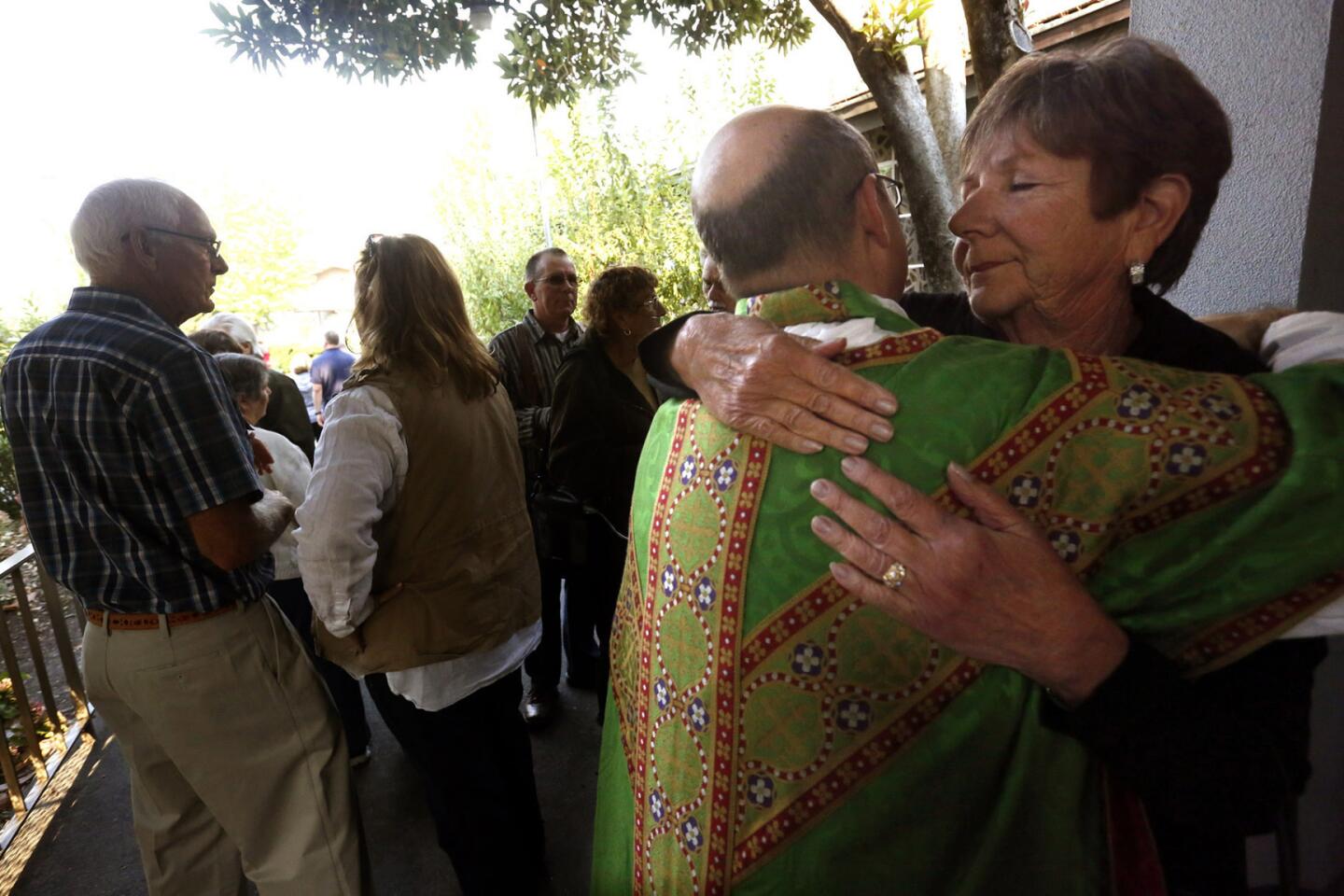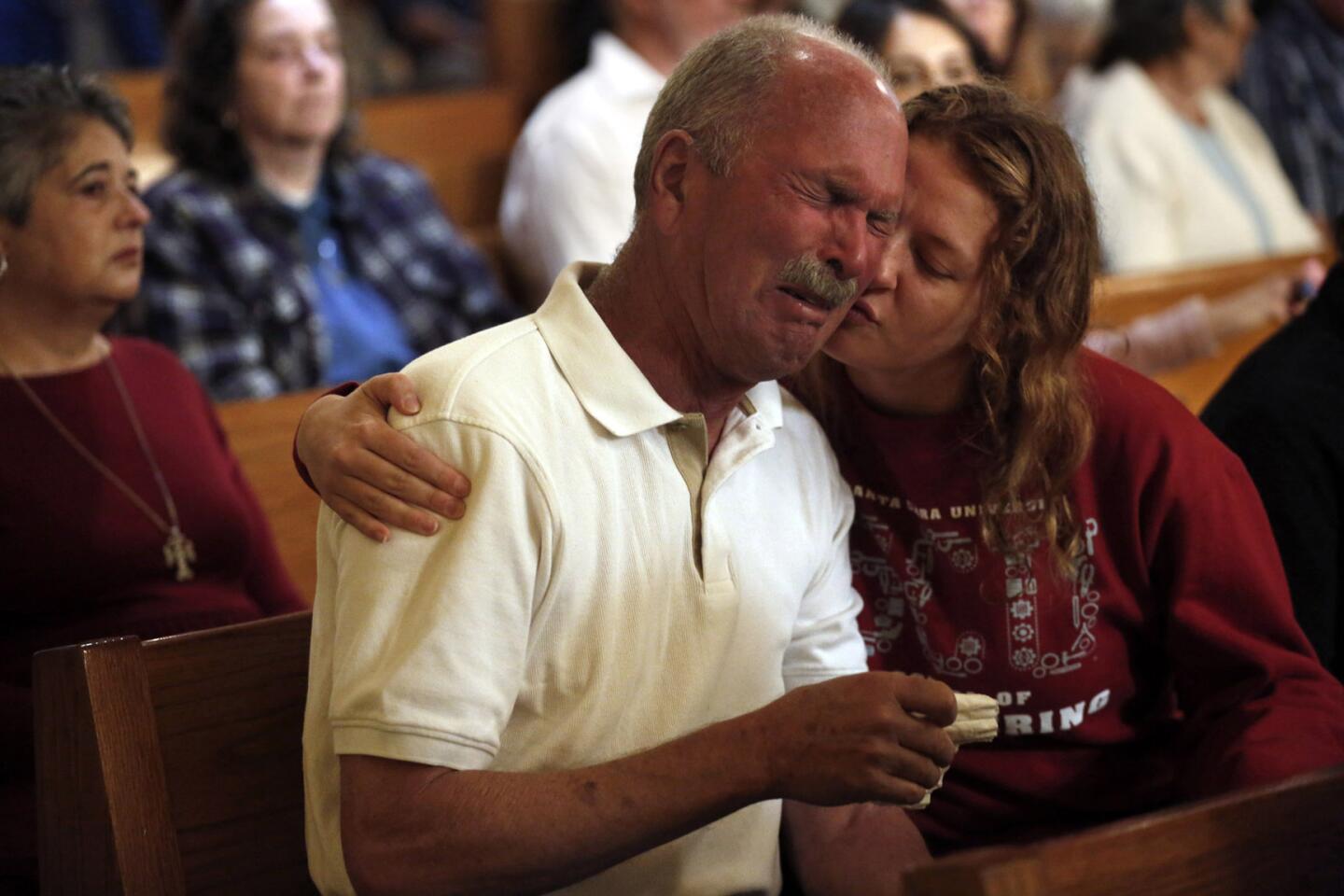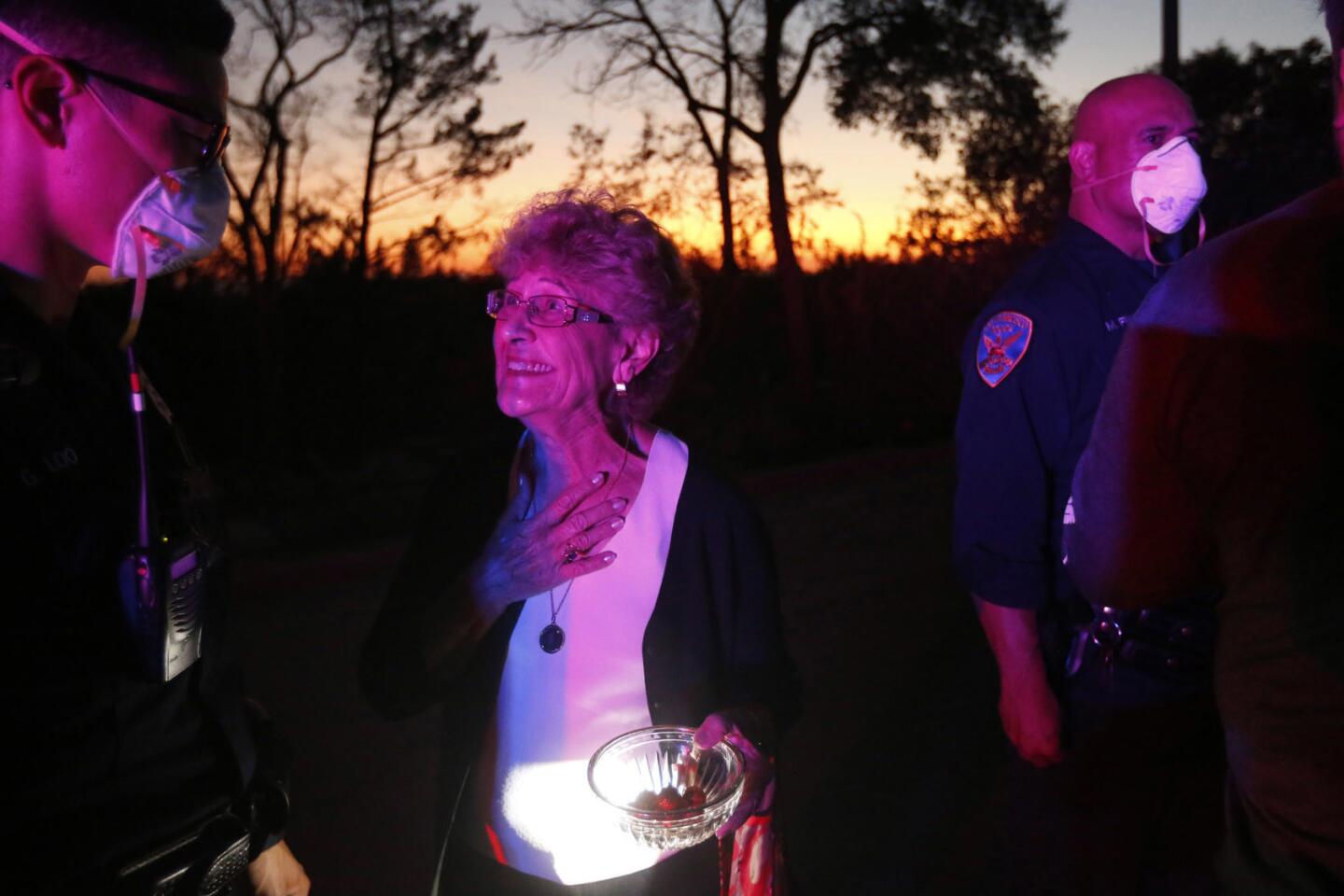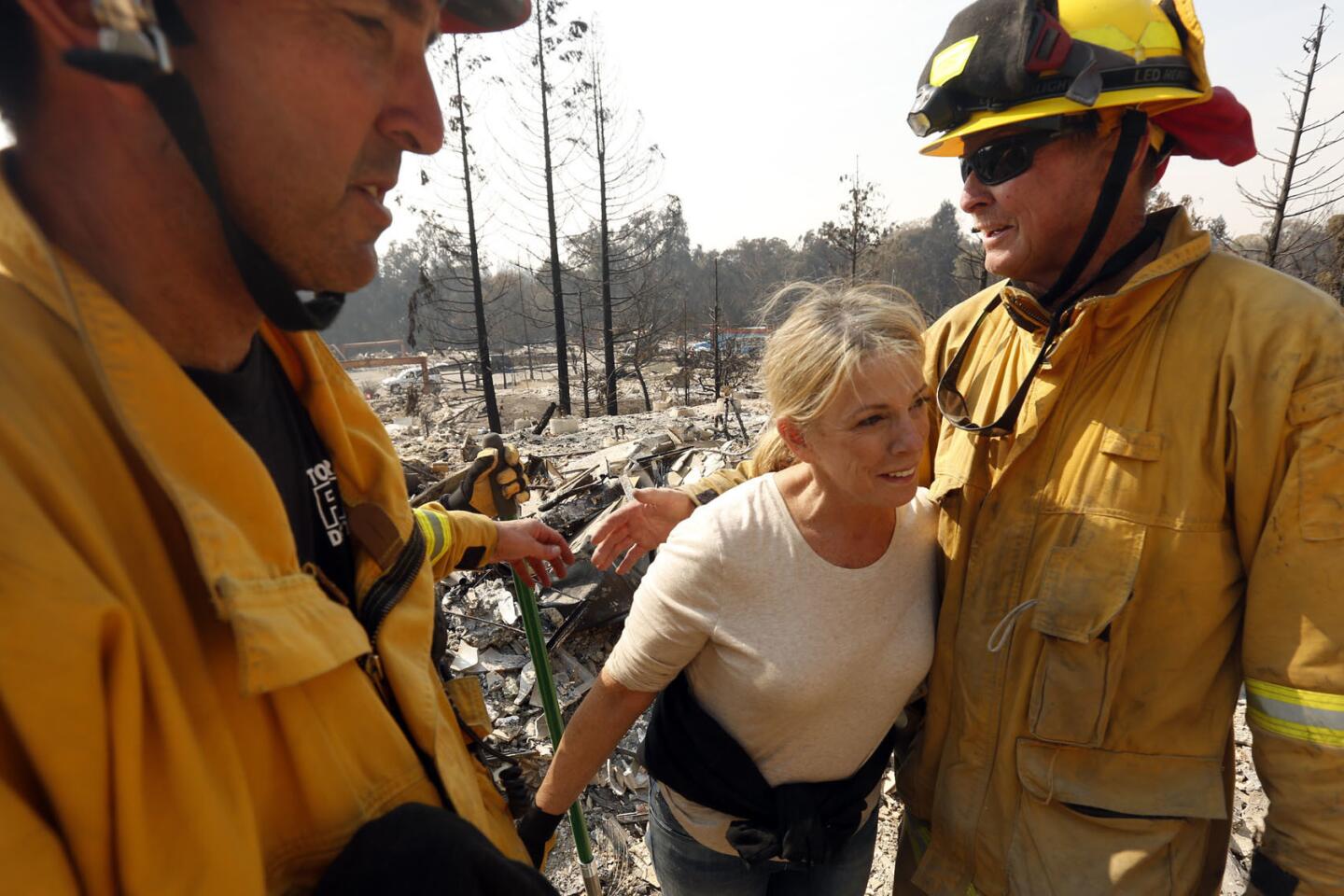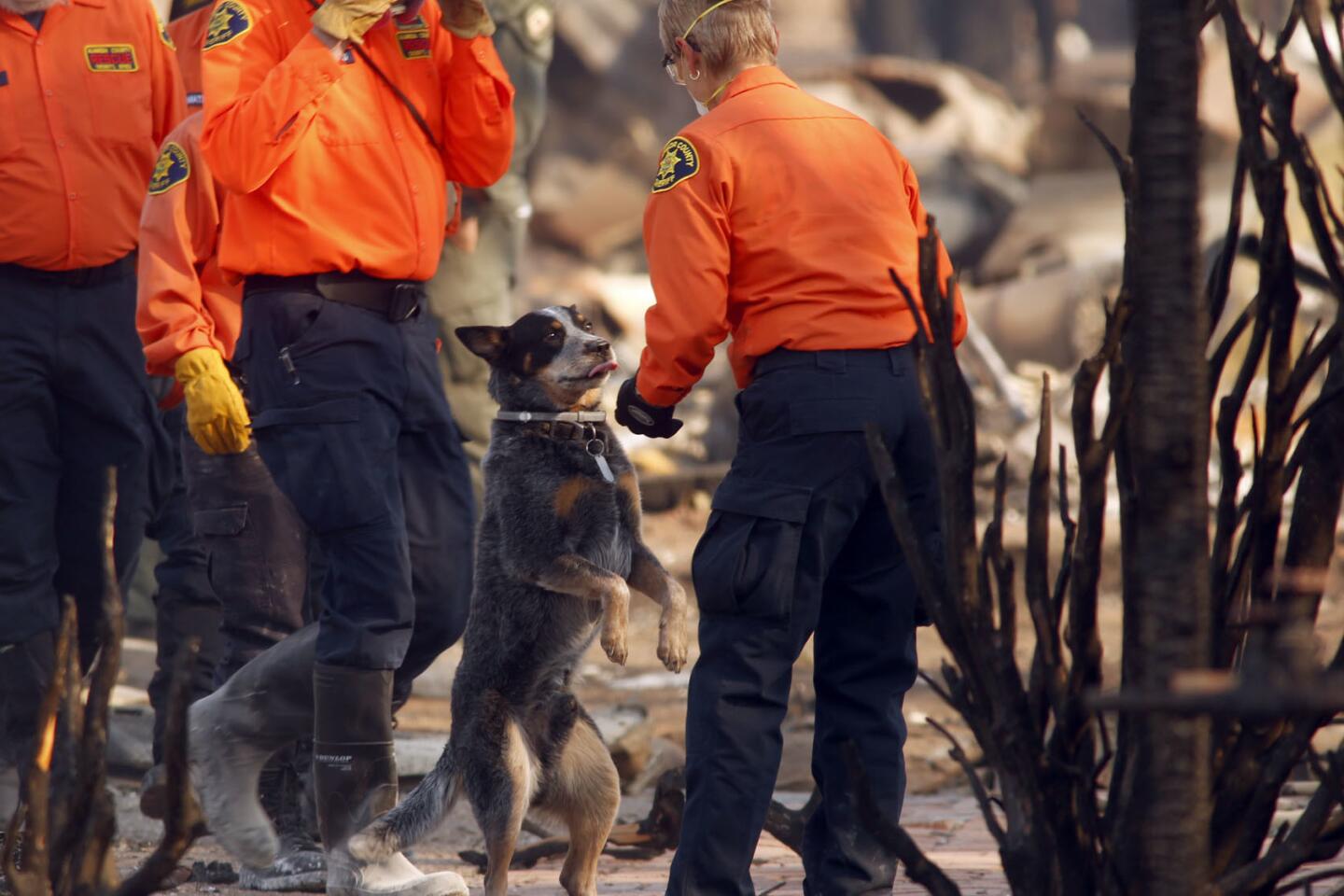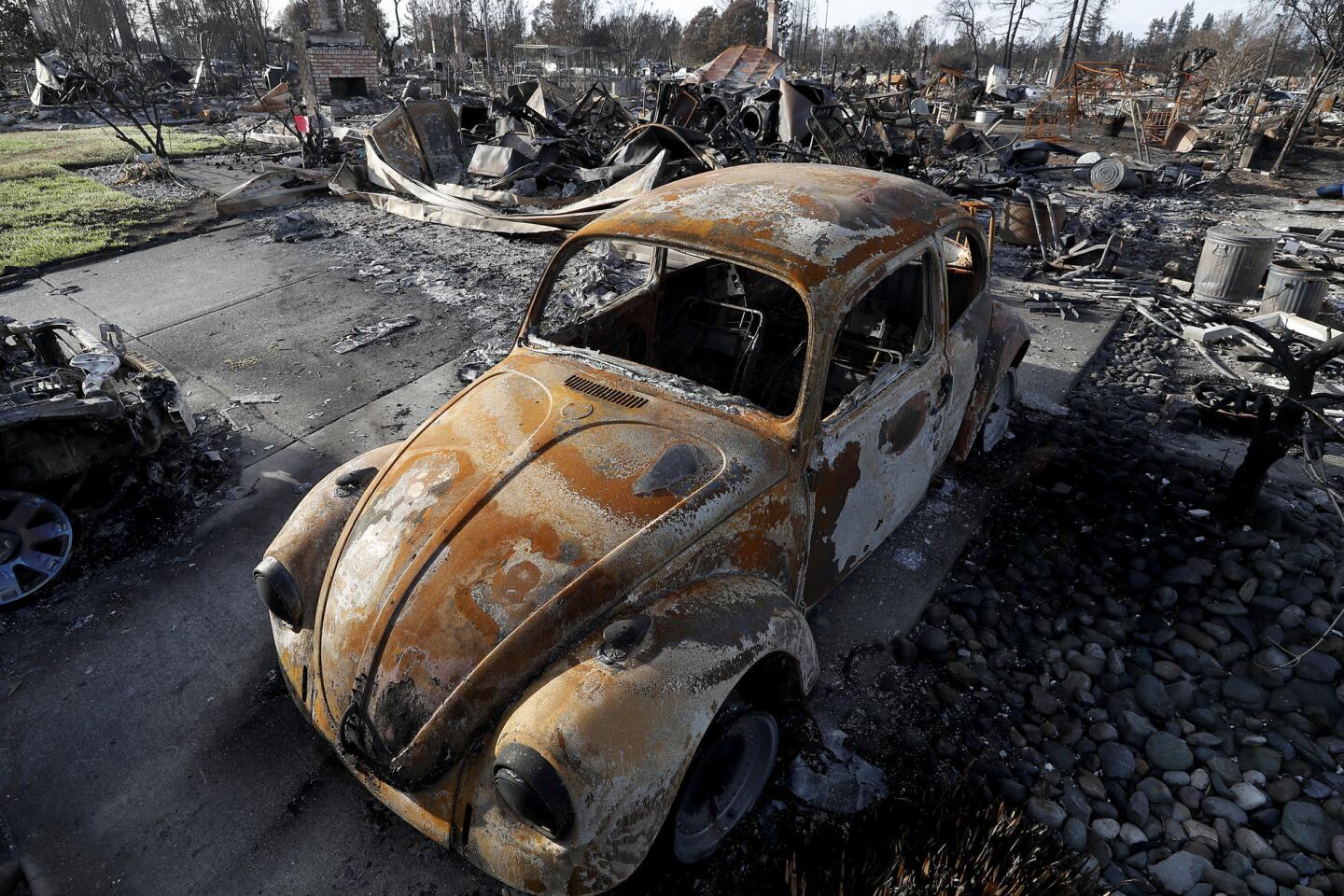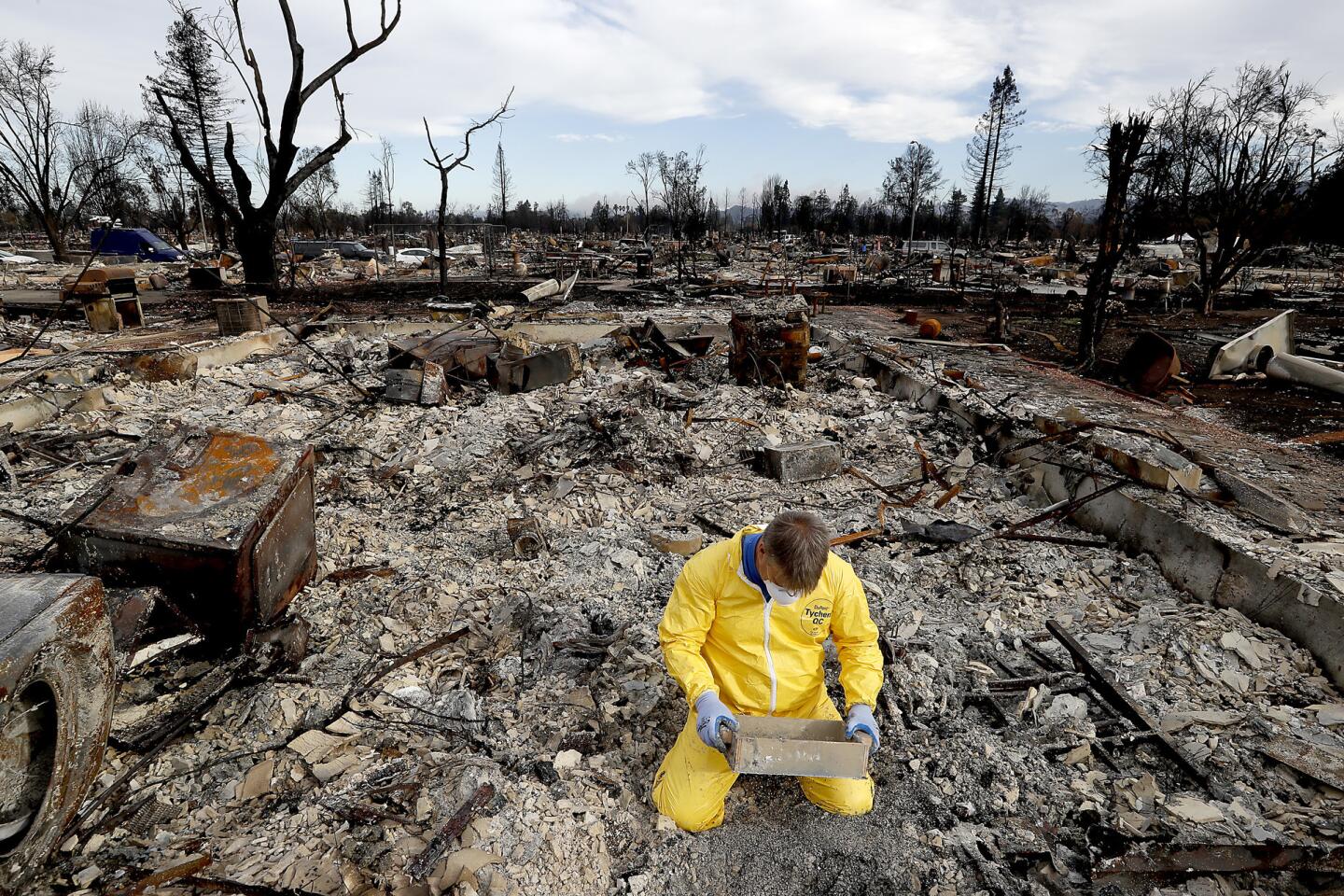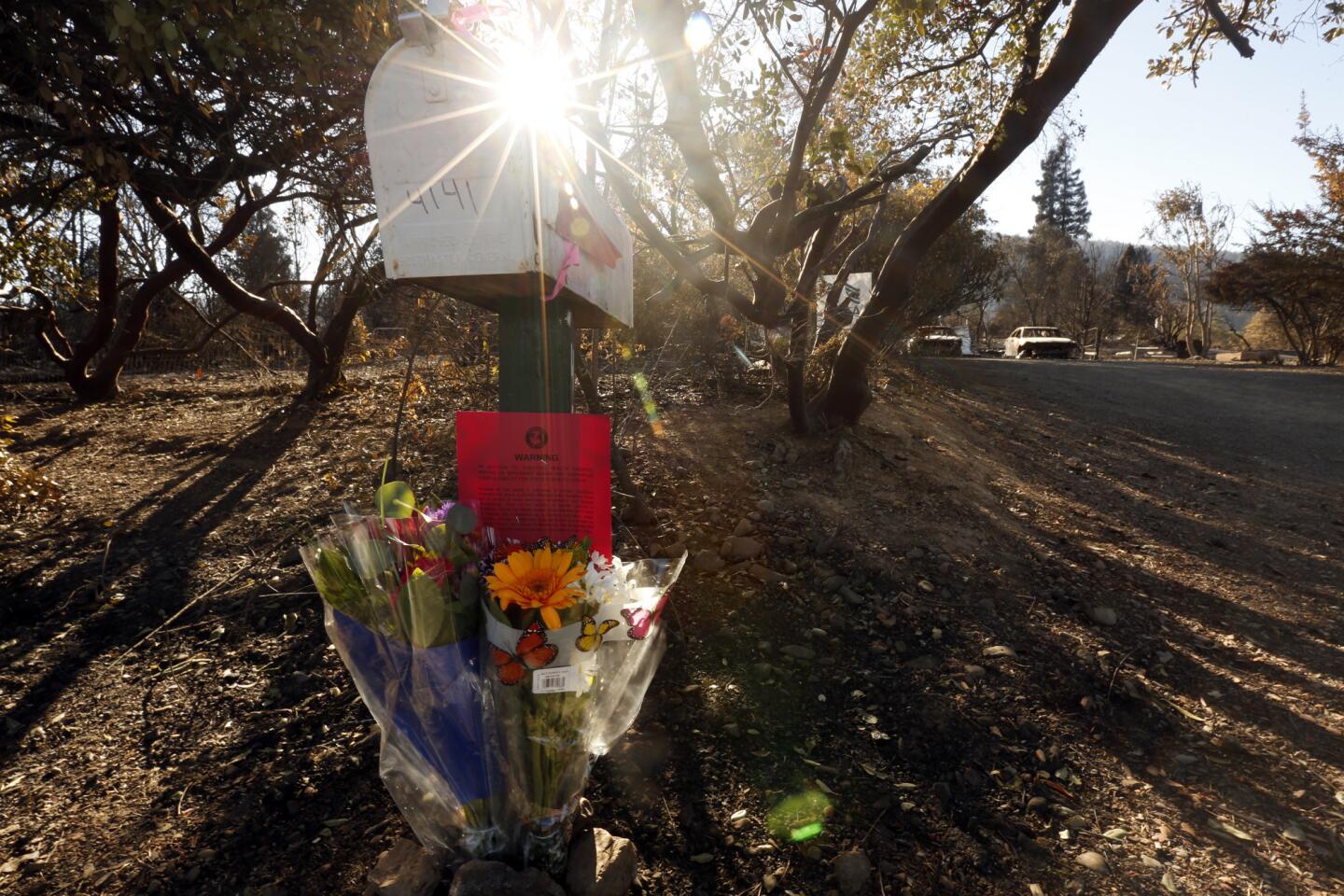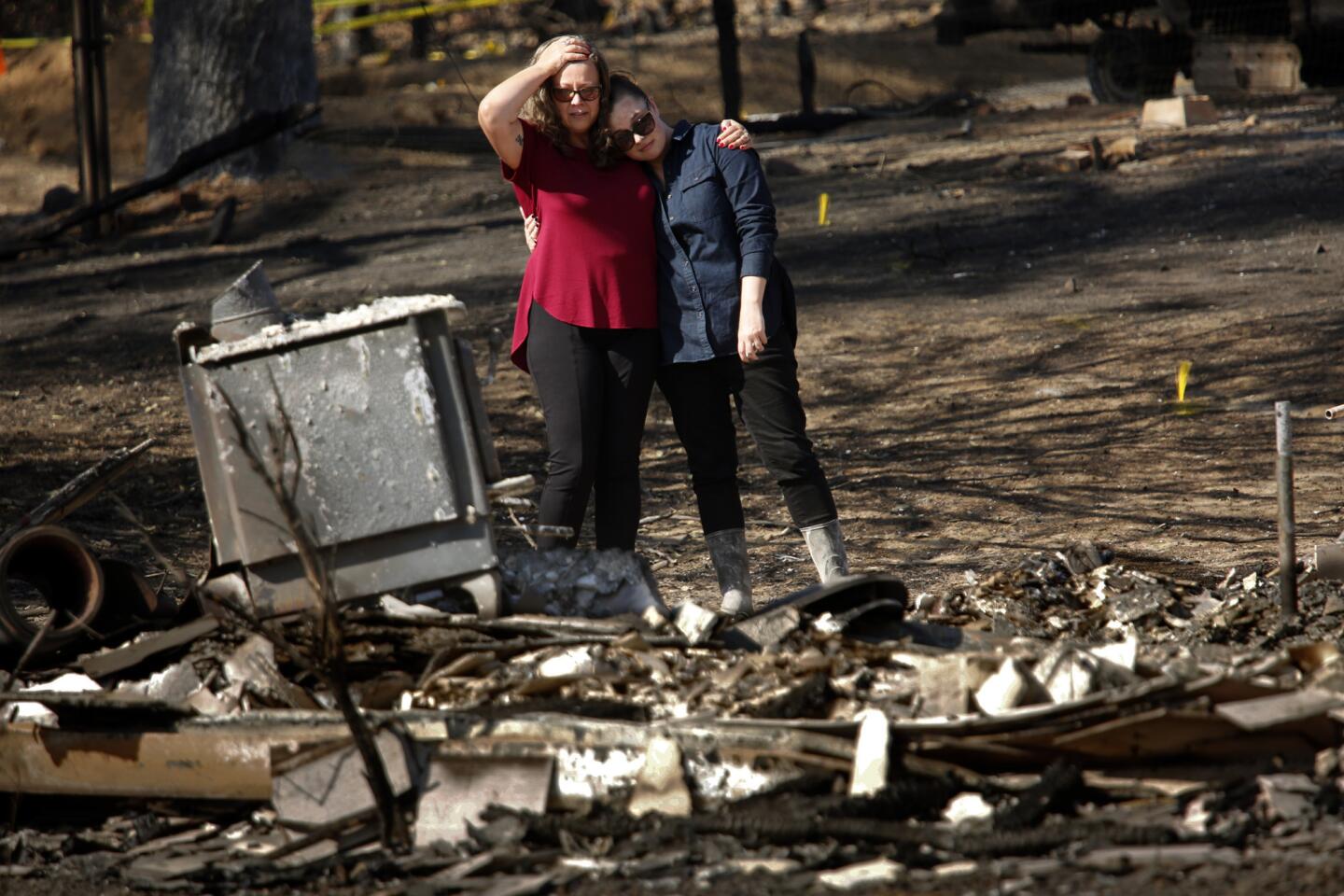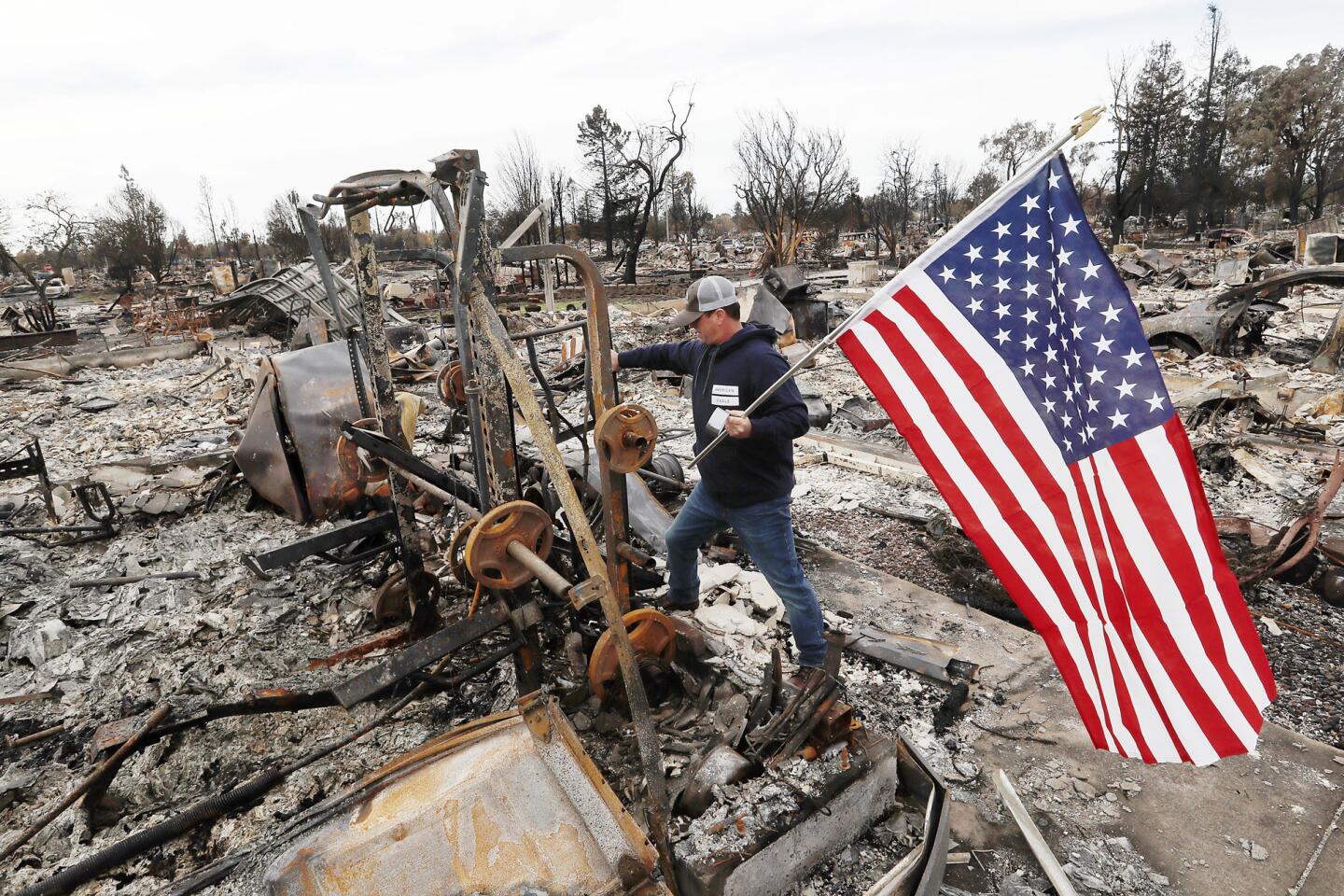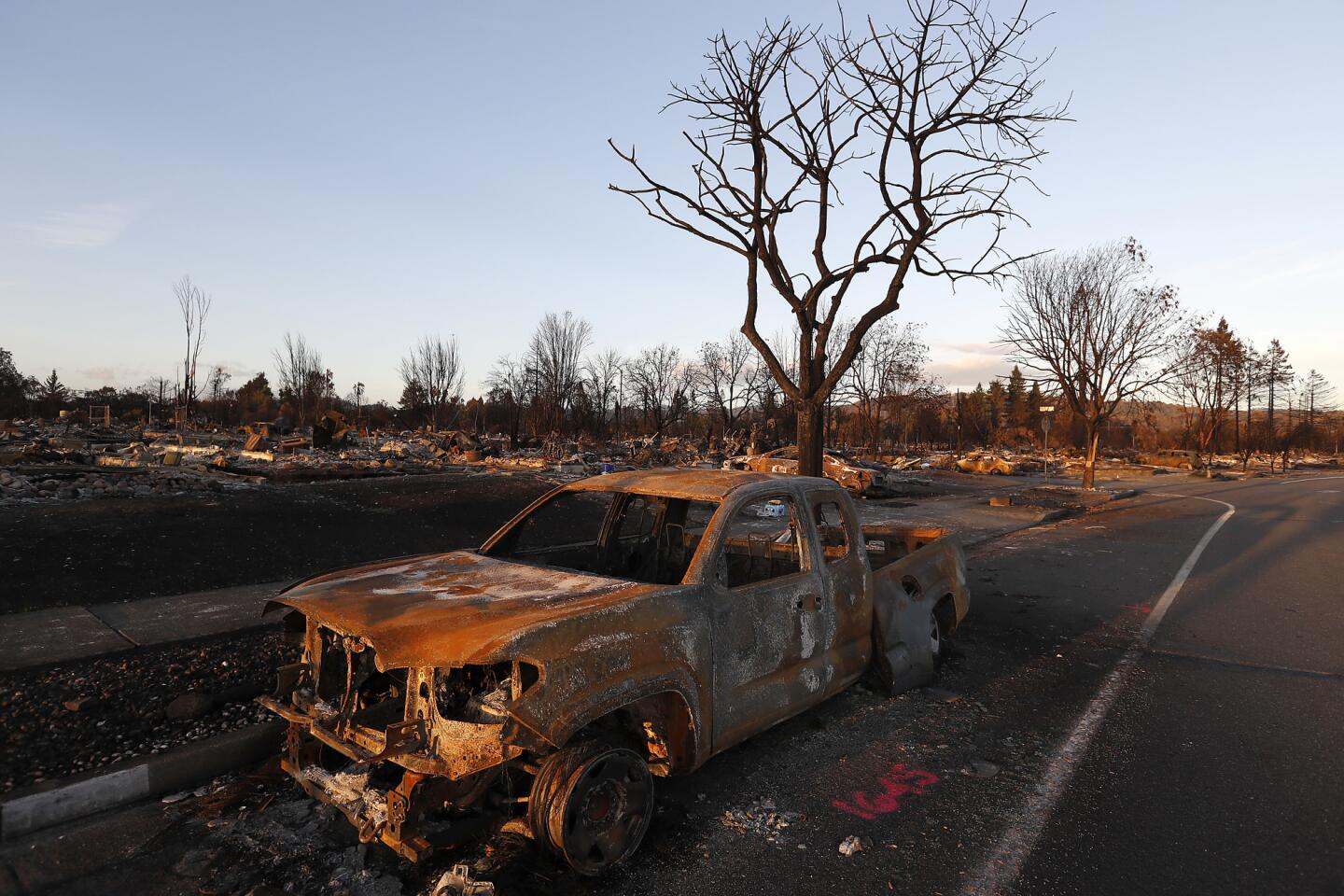Napa, Sonoma counties did not issue Amber Alert-style warnings ahead of fires

Over 160,000 acres have been destroyed in northern California fires.
- Share via
Reporting from SANTA ROSA, Calif. — As fast-moving fires invaded neighborhoods across Northern California this week, residents in Napa and Sonoma counties said they were alerted to the approaching disaster by frantic shouts from neighbors, honking horns, blaring smoke alarms and even the noise of an American flag whipping in the intense winds.
But it’s becoming increasingly clear that residents did not receive warnings on their cellphones similar to an Amber Alert. The so-called Wireless Emergency Alert sends loud, screeching alarms or vibrations to all cellphones in a geographic area unless a user specifically opts out.
Officials are now facing questions about why authorities could not reach more people as the fires barreled toward homes late Sunday night and early Monday.
Neither Sonoma County nor Napa County sent out warnings through the Wireless Emergency Alert system, officials said.
Sonoma County officials had contemplated sending out such an alert, but decided against it because of the concern the alert would have pinged “every cellphone connected to a cell tower in Sonoma County,” Jennifer Larocque, a county spokeswoman, said Thursday. That could have caused unnecessary gridlock on the streets of the county far away from the fire and could have impeded the arrival of emergency responders to threatened areas, she said.
Wireless Emergency Alerts, however, can be used in other jurisdictions to target a smaller area. A Federal Communications Commission fact sheet says the system enables officials to target warnings to specific geographic areas, such as lower Manhattan. The city of Los Angeles last year directed such an alert to cellphones just within a 2½-mile radius of Los Angeles International Airport to update people that a potential security incident had been resolved.
Sonoma County Sheriff Rob Giordano said Wednesday that the county sent out warnings through its SoCoAlert service and Nixle, both systems that require residents to register in advance in order to receive messages. The county also sent out reverse 911 calls to landlines in unincorporated areas. Santa Rosa, where block after block of suburban homes was destroyed, sent out alerts through SoCoAlert, Nixle and on social media.
Sonoma County is among dozens of California jurisdictions that applied for and received authority from the federal government to issue Wireless Emergency Alerts.
Napa County issued alerts through Nixle, but officials said some residents had trouble receiving the warnings.
The death toll from the fires rose Thursday to at least 29, with some victims simply unable to outrun the flames. An estimated 3,500 homes, businesses and other structures were burned.
In the devastated Coffey Park neighborhood of Santa Rosa, some residents of scorched homes said they were surprised they didn’t get an alert on their phones.
Michael Desmond, 59, a retired Homeland Security investigator, said he was lying in bed Sunday night skimming news stories on his iPad when he heard a commotion outside. Finally, he heard what a firefighter was saying: “Firestorm. Get out of here now! Take nothing! Just go!”
“So I got my dog. I got my wallet. Got my keys. And left,” he said Wednesday, as he walked down the street of his neighborhood carrying a charred mailbox, one of the few things he was able to salvage from his home destroyed by wildfire.
“I think they were totally unprepared for this,” he said.
A few blocks away, high school teacher Anna Solano, 50, said she also received no phone warning.
Solano, who on Wednesday sifted through the ashes of her home looking for keys to equipment lockers and classrooms, had smelled smoke earlier Sunday evening but thought there was just a house fire in the area. About 2:30 a.m. Monday, a man knocked on her door and kept banging, waking up Solano’s dog, who eventually woke her up.
“That gentleman saved our lives. A stranger,” she said. “We saw the fire coming. We left here in five minutes.”
The fire — one of the most destructive in California history — moved through northern Santa Rosa swiftly, with winds clocking 50 mph carrying embers that ignited numerous spot fires, burning down entire neighborhoods.
“The fire came through the night. It was rapidly moving,” said Mark Ghilarducci, director of the California Governor’s Office of Emergency Services. “Some people were awakened while the fire was actually on their doorstep.”
Sonoma County officials said it will take time to determine the reach of the alerts they tried to issue.
“I don’t know how effective that was,” said Giordano, the Sonoma County sheriff. “It’s going to take a long time until we understand that.”
The Wireless Emergency Alert system was rolled out in 2012, and California used it to send an Amber Alert for the first time in 2013. The alerts are transmitted on an exclusive frequency that can reach many people at the same time, and Amber Alerts — which notify the public of the case of an abducted child — have proved to be effective.
Alerts such as these have been used to warn New Yorkers about the approach of Hurricane Sandy and tell the people of Moore, Okla., about the arrival of a massive tornado.
But some local jurisdictions don’t use them — or don’t know how.
This year, San Jose officials were roundly chastised for failing to warn the public about destructive floodwaters before they overflowed through densely populated neighborhoods along Coyote Creek amid the winter’s heavy rains.
In July, a withering report concluded that in San Jose, “there was a general lack of institutional knowledge” on how to broadcast alerts on the Wireless Emergency Alert system. San Jose itself at the time was not set up to issue such alerts on its own. Santa Clara County did have the ability to do so, but no one from the city asked the county to release an alert on its behalf.
For local authorities to use the federal system, municipalities need to apply to the Federal Emergency Management Agency to become an alerting authority. Besides the city of Los Angeles, Orange County, San Francisco and Sacramento County are among the jurisdictions that have registered to use the wireless alert system.
Napa County is not listed. Heather Ruiz, a spokeswoman for the Napa County Office of Emergency Services, said her county has not been using the Wireless Emergency Alert system and was not sure if they had the ability to do so. Instead, they issue alerts through Nixle.
Mark Eggan, the Napa County Sheriff’s Office information technology chief, said 1,500 people responded to a Nixle alert Sunday night by clicking on a link to the department’s web server, causing it to crash. During the server’s crash, people could read the brief message on their phones, but the link to get further information did not work. Eggan said the system had never been taxed like that before.
There can be hiccups with Wireless Emergency Alerts. In Los Angeles, a message can be directed to a zone of just a quarter-mile from a single point. But due to the complexities of cellphone communications, a message directed to cellphones around the Port of Los Angeles might inadvertently be picked up by a few cellphones in the distant San Fernando Valley.
And because Wireless Emergency Alerts offer only 140 characters, the wording of a notice needs to be very carefully worded “to not trigger undue panic and undue evacuations,” said Kate Hutton, spokeswoman for the Los Angeles Emergency Management Department. “You don’t want to confuse people.”
So there’s a balancing act emergency management officials need to deal with in a crisis. “You never want to unnecessarily scare people or wake them up. But … we have to factor in people’s lives,” Hutton said. “That might mean alerting people outside the alert area. That’s an unfortunate reality with the technology we have.”
This week, Napa County officials said it’s possible alerts were hampered by fire damage to cellphone towers. The fragility of the cellphone tower network — highlighted by natural disasters in Texas, Florida and Puerto Rico — caused the chairman of the Federal Communications Commission, Ajit Pai, to put the spotlight on technology in cellphones that can be used to receive alerts through a chip that can receive FM radio signals, which can work even when cellphone towers are powerless or destroyed.
Though other cellphone manufacturers equip their phones with FM chips, Apple says its most recent models, the iPhone 7 and 8, do not have them.
“It is time for Apple to step up to the plate and put the safety of the American people first,” Pai said in a statement released last month.
Pai said he has long urged cellphone manufacturers that had turned off FM chips on their cellphones to reactivate them, so that people can use them to “get vital access to life-saving information.” He applauded companies that have done so, and singled out Apple as “the one major phone manufacturer that has resisted doing so.”
In a statement, Apple said the company “cares deeply about the safety of our users” and noted that users can dial emergency services and receive Amber Alerts and emergency weather notifications. The company did not respond to questions about whether the company would install FM chips in future models of the iPhone.
Fires in Northern an Southern Calif. create widespread damage, destroying homes and claiming live
Listed below are the jurisdictions in California, as of Aug. 8, with the authority to issue Wireless Emergency Alerts, which are transmitted through FEMA’s Integrated Public Alert and Warning System (IPAWS).
- Alameda County Operational Area
- Butte County
- California Governor’s Office of Emergency Services
- California Highway Patrol
- City of Lancaster
- City of Los Angeles
- City of Monterey Park
- City of Moreno Valley Emergency Operations Center
- City of Oakland
- City of Rancho Cucamonga
- City of San Leandro
- City of Tehachapi
- City of Torrance Police Department
- Contra Costa County Office of the Sheriff
- County of Sacramento
- County of Tulare
- County of Tuolumne
- Fresno County Sheriff-Coroner’s Office
- Lake County Sheriff’s Office of Emergency Services
- Madera County Sheriff’s Department
- Marin County Sheriff’s Office of Emergency Services
- Mendocino County Sheriff’s Office
- Merced County Office of Emergency Services
- Mono County Sheriff’s Office
- Monterey County
- Northern California Regional Intelligence Center
- Orange County
- Placer County Office of Emergency Services
- Riverside & San Bernardino Counties (LECC)
- San Diego County Office of Emergency Services
- San Francisco Department of Emergency Management
- San Francisco International Airport
- San Joaquin County Office of Emergency Services
- San Luis Obispo County Office of Emergency Services
- Santa Barbara County
- Santa Clara County Office of Emergency Services
- Santa Cruz Regional 9-1-1
- Shasta Area Safety Communications Agency (SHASCOM)
- Siskiyou County
- Solano County Sheriff’s Office of Emergency Services
- Sonoma County Fire and Emergency Services Department
- Stanislaus County Office of Emergency Services
- Tehama County Sheriff’s Office
- Town of Truckee Police Department
- Ventura County Sheriff’s Office - Office of Emergency Services
- Yolo County
These jurisdictions in California, as of Aug. 8, were in the process of obtaining the ability to issue Wireless Emergency Alerts.
- Arcata Police Department
- Camp Roberts Maneuver Training Center
- City of Benicia
- City of Culver City
- City of Duarte
- Clearlake Police Department
- Fort Hunter Liggett
- Glendora Police Department
- Los Angeles County Los Angeles World Airports
- Mariposa County Sheriff’s Office
- San Bernardino County Fire Department
- San Mateo County
- Union City Police Department
- United States Army Garrison Presidio of Monterey
- UCLA
- U.S. Army Garrison Fort Irwin
Willon reported from Santa Rosa, Calif., Megerian from Mather, Calif., St. John from Napa, and Lin from Los Angeles.
UPDATES:
5:30 p.m.: This article was updated with a higher death toll in the Northern California fires.
3:30 p.m.: This article was updated with a quote from a Sonoma County spokeswoman saying the county had decided against sending out a Wireless Emergency Alert. It was also updated with information about how Wireless Emergency Alerts can be used to target smaller areas, and a quote from a spokeswoman from the Los Angeles Emergency Management Department.
Oct. 12, 7:30 a.m.: This article was updated with a map and an image of an alert.
This article was originally published at 7:40 p.m. on Oct. 11.
More to Read
Sign up for Essential California
The most important California stories and recommendations in your inbox every morning.
You may occasionally receive promotional content from the Los Angeles Times.
